#early public education has a focus on community and natural science
Explore tagged Tumblr posts
Note
Don't you find the strict rules of society in Japan overwhelming for you and the kids?
not one bit
#i can’t express how safe i have felt here versus the US over the past several years specifically#no guns… good healthcare… clean environment… good childcare benefits… good food…#no strong religious chokehold permeating society#vaccines and masking aren’t a moral conundrum#functioning public transportation system#functioning postal system#don’t have to worry about people randomly yelling at you#many convenience stores open 24/7#focus on seasonal eating so produce tastes better and you appreciate it more#i can walk the streets at night#in my city all childcare costs and child medical costs are waived up to 3 years old#cost of childbirth fully covered including a week long stay in the hospital after#you can drink the water#early public education has a focus on community and natural science#credit cards are automatically set up to autopay out of your bank account#my company does my taxes for me#did i mention no guns?#i could go on#like i have my philosophical issues with the country for sure but my base needs are covered and that means a lot as a parent
45 notes
·
View notes
Text
OPG World School's Unique Approach to Fun-Filled Education: Captivating Minds, Inspiring Joy
The classroom has no longer been considered as the place of learning. OPG World School, one among the best schools in Dwarka, makes learning a delight by innovative teaching methods along with fun activities. Therefore, the unique approach offered by the school provides excellent academics along with creativity, collaboration, and critical thinking that makes it one among the top-rated schools in Dwarka.
The Vision of OPG World School
OPG World School is a CBSE school in Dwarka Delhi, located in the heart of Dwarka, understanding the evolving needs of education in the 21st century. It brings in state-of-the-art infrastructure with dynamic teaching strategies for an engaging environment. Nursery to senior secondary classes find a place here, making it one of the most sought-after CBSE schools near me for holistic development.
Blending education with entertainment
The focus here on the integration of entertainment with the process of learning is a key differentiator for OPG World School. It conducts periodical activities, which mix academics with play, making the kids learn while playing. It is one of the most reputed CBSE schools in Dwarka and also highly sought by parents seeking a "school near me" which can equally balance learning and enjoyment.
Interactive Classrooms
Classrooms at OPG World School are equipped with the latest technologies, including smart boards and projectors. These instruments bring lessons to life in the minds of students and make them easier to understand. In addition, it is one of the most rated AC schools in Dwarka, which creates a comfortable and learning-friendly environment.
Hands-On Learning
OPG has experiential learning. The students enjoy experiments in science, works of art, and group discussions, and through these interactive programs, the confidence and solving capabilities develop. This enhances one's chances of thriving in today's competitive atmosphere. Parents searching for a school near me with fee structure have often appreciated value-driven education in OPG World School.
Fun-Filled Extracurricular Activities
The school calendar is a treasure trove of extracurricular activities that make the syllabus go beyond books. Be it dance, drama, sports, or music, every student has numerous opportunities to pursue his or her interests. There are talent shows, inter-house competitions, and cultural fests which make OPG World School a cbse based school in dwarka that celebrates individuality.
Outdoor Adventures
Field trips and excursions make up the heart of OPG World School curriculums. Such activities range from nature camps to even historical site visits which raise students' exposure to real life and subsequently their learning in school positively. For this reason, parents get a choice toward more global international schools near me or play schools near me.
Sports focus:
Sports play a vital role in forming young minds. OPG has a vast variety of sports, such as basketball, cricket, and yoga. Sports facilities are enormous and create it one of the top-rated AC schools in Dwarka, where academics and physical fitness are taken up on equal footing.
Building Future Leaders
OPG World School works on future-ready individuals through leadership programs and workshops. Debates, public speaking, and model UN sessions help students communicate and enhance their leadership skills. Therefore, for parents searching for "CBSE school admission near me" or "admission open in Dwarka school," they often choose OPG, which provides all-round development.
Early Education at Its Best
OPG World School is a haven for parents who are scouting nursery school admission Dwarka or nursery admission dwarka near me as the school provides a great play-based curriculum that builds on cognitive, social, and emotional skills in children.
Affordable yet Premium
One of the top rated school in dwarka OPG World School provides premium education at affordable fees. The transparent fee structures and flexible admission processes make it a favorite among families looking for CBSE schools near me for 11 and 12 Dwarka or schools nearby me for all grade levels.
Admissions Made Easy
Admission open in Dwarka schools and OPG World School has made the admission process much easier. Parents can find the online CBSE school admission form Dwarka or get it from the school campus. The school accepts students from all walks of life, be it Class 1 or senior classes.
Why Choose OPG World School?
Top Scholars: It is one of the top 5 CBSE schools in Dwarka, offering excellent academic results and the most advanced curricula followed as per CBSE.
Innovative Infrastructure: It is a private CBSE school that is said to be a benchmark in providing the most advanced infrastructure in terms of education.
Community Engagement: Events and initiatives ensure that students are always connected with their community. Parents look for education school in Dwarka who appreciate this aspect.
Global Exposure: With partnership and collaboration, OPG is like an international school which provides global opportunities.
A Testimony to Excellence
The school's perfect amalgamation of academics, fun, and extracurricular activities has made it a world school in Dwarka. Parents term it one of the best top 10 schools in dwarka, perfect for senior students to succeed.
Conclusion
More than a place for education, it is creativity, curiosity, and wholesome growth. One of the top rated cbse school in dwarka, OPG World School stands out owing to the integration of enjoyment with academics. From holding significant academic credentials to many extracurricular activities, the epitome for modern education is OPG World School.
This will be for parents who want to know "schools near me for class 1," "CBSE admission for class 1 Dwarka," or "available schools for admission in Dwarka." OPG World School will be the one to pick. Experience education like never before—because every day is a step forward in a brighter, fun-filled future at OPG.
0 notes
Text
A Sustainable and Fair Future
Imagine a world 80 years from now where life has changed in some ways :
Food
Our approach to food will be healthier and more sustainable. Imagine nutrient-packed meals grown in urban farms or printed on demand at home. We’ll rely less on traditional agriculture and meat, instead embracing options like lab-grown protein and plant-based foods that taste great and are kind to the planet.
Water
Clean water will be accessible everywhere, thanks to advanced desalination and recycling technologies that can turn saltwater or even waste into fresh, drinkable water. Simple, effective filtration at home will make safe water a guarantee, even in places where it once was scarce.
Housing
Homes will be flexible and sustainable, with modular designs that expand or shift as families change. Cities will be vertical and green, full of light-filled buildings that coexist with nature, bringing trees, gardens, and fresh air into every corner of urban life. And every building will be built to handle the weather extremes of the future.
Education
Learning will be a personalized, lifelong journey accessible to anyone, anywhere. Imagine VR-based classrooms where students of all ages can explore history, science, and art firsthand. Education will prioritize creativity, critical thinking, and emotional intelligence, helping people grow beyond traditional subjects.
Healthcare
Healthcare will focus on keeping people well, not just treating them when they’re sick. Predictive technology will detect issues early, allowing us to get ahead of problems before they start. Small, microscopic “nanobots” might even monitor our health from inside, delivering medicine or performing minor repairs as needed.
Social Equity
With systems like universal basic income, financial safety nets will help ensure no one is left behind. Sharing resources and decentralized ownership will close the wealth gap, ensuring that people can access essential services regardless of where they’re from or how much money they have.
Gender Equality
Automation and changing attitudes will dissolve outdated gender roles, creating true equality. Work and family responsibilities will be shared, and workplaces will be structured so that opportunities, pay, and respect are the same for everyone, regardless of gender.
Work & Income
As repetitive work becomes automated, we’ll focus more on creative and meaningful jobs that require human insight and compassion. With financial stability guaranteed through universal income or similar policies, people will be able to pursue passions, whether that’s in the arts, technology, or environmental conservation.
Energy / Electricity
Energy will be clean, local, and abundant. Communities will generate and store their own energy through solar panels, wind turbines, and powerful batteries, making cities resilient to power shortages and blackouts. Even on an individual level, we’ll be able to capture and use energy from our own daily movements.
Peace & Justice
AI will help keep systems fair and honest, highlighting inequalities or biases in real-time. Legal processes will be faster and more transparent, with virtual courtrooms making justice more accessible. A global community will work together to monitor and protect human rights, creating peace and stability.
Transportation
We’ll have more eco-friendly, fast, and efficient transportation options, from self-driving cars and trains to flying and even underwater vehicles. Public transportation will be easy to access and free, making travel affordable and enjoyable for everyone.
Political Voice
Secure, transparent voting will ensure that everyone’s voice is heard, with blockchain-backed systems making elections safe and accessible. Citizens will engage more directly with policies, using simulations to understand the real-life impact of proposed laws before they’re enacted.
Air Pollution
Cities will integrate air-cleaning plants and natural “lung zones” that filter pollution, while green architecture and technology will keep the air fresh. Bioengineered plants along streets and buildings will absorb harmful particles, making urban environments healthier for everyone.
Noise Pollution
Noise-canceling barriers will create peace in busy cities. Highways, factories, and airports will have soundproofed zones, while personal sound “bubbles” will allow us to enjoy quiet moments, even amid urban hustle and bustle.
Non-Human Life
Animal welfare will improve drastically, as lab-grown meats and sustainable diets make factory farming unnecessary. Wildlife corridors will connect green spaces, allowing animals to roam safely, and cities will welcome animals as co-inhabitants, creating harmony between urban life and nature.
Chemical Pollution
High-tech filtration and strict controls on waste will keep harmful chemicals from entering our ecosystems. Chemical production will be closely monitored, and real-time feedback systems will alert authorities to potential dangers, ensuring a cleaner, safer environment for future generations.
Water Bodies & Supply
Our rivers, lakes, and oceans will be carefully protected, with advanced monitoring systems and sustainable practices keeping aquatic ecosystems healthy. Water recycling will return clean water to these ecosystems, restoring balance and supporting both human and non-human life.
Waste Management
All materials will be recycled or composted, with smart sorting systems helping us process waste efficiently. Biodegradable packaging will eliminate plastic, and products will be designed to be taken apart and reused, so nothing goes to waste.
Land Use & Public Spaces
Urban spaces will blend residential, commercial, and natural spaces. Streets will focus on pedestrians, with parks and green areas woven into every neighborhood. Public areas will serve multiple functions as places to meet, relax, and connect with nature.
Ocean Pollution
Floating filtration systems and biodegradable materials will help reduce pollution in oceans. Robots will roam the seas, collecting plastic and debris for recycling, while marine sanctuaries will provide safe havens for wildlife, preserving our ocean’s natural beauty.
Effects of Climate Change
Climate stabilization techniques like carbon capture will be used responsibly to ease extreme conditions. We’ll build cities and agricultural systems that can adapt to unpredictable weather, helping people and ecosystems thrive despite changing climates.
Urban Agriculture & Greenification
Vertical farms and green spaces will be integrated into city design, bringing fresh produce closer to home. Rooftop gardens, green walls, and other urban agriculture initiatives will provide food, clean air, and natural beauty in urban settings.
Gender & Sexuality
Gender and sexuality will be fully embraced as diverse, fluid aspects of identity. All identities will be respected and supported by society, with protections ensuring inclusivity across all areas of life, from healthcare and education to work and community.
Diversity & Inclusion
Diversity will be seen as essential to a healthy society. People from all backgrounds will be represented and respected in every sphere, creating a truly inclusive world. AI tools will help ensure fair representation and eliminate bias in media, workplaces, and educational settings.
Accessibility
Physical and digital spaces will be designed with universal accessibility in mind. Advanced prosthetics, virtual reality, and new technologies will allow people to navigate the world seamlessly, while public policies ensure that all buildings and products are accessible to everyone.
Sustainability
Sustainable living will be second nature, with circular economies that focus on reusing resources and minimizing waste. AI will help us track resources carefully to reduce our impact, while restorative practices like reforestation and regenerative farming allow ecosystems to flourish.
0 notes
Text
Christine Ortiz named director of MIT Technology and Policy Program
New Post has been published on https://thedigitalinsider.com/christine-ortiz-named-director-of-mit-technology-and-policy-program/
Christine Ortiz named director of MIT Technology and Policy Program
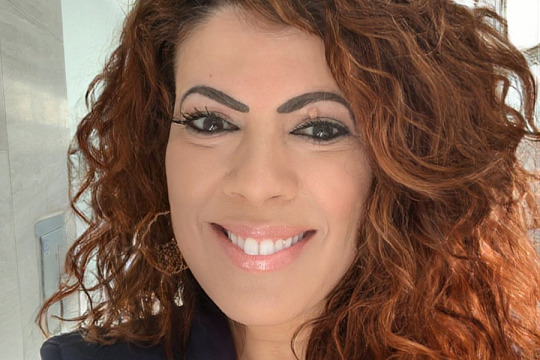

Christine Ortiz, the Morris Cohen Professor of Materials Science and Engineering at MIT, has been named the next director of the MIT Technology and Policy Program (TPP).
“Christine is a force of nature,” says Fotini Christia, the Ford International Professor of the Social Sciences and director of the MIT Institute for Data, Systems, and Society (IDSS), which houses TPP. “Her years of service to the Institute, her support of grad students in particular, her research focus on innovation and the social good, and her network of connections across academia, industry, and government all make her the right leader for the program. At a time when technology has become such a critical part in informing evidence-based policy, I am confident that Christine will take TPP to the next level.”
Ortiz is a professor, engineer, scientist, entrepreneur, former dean, corporate board director, and foundation trustee. She is an internationally recognized researcher in biotechnology and biomaterials, advanced and additive manufacturing, and sustainable and socially-directed materials design. She has over 30 years of experience in science, engineering, research and development, and technology innovation. She has published more than 210 publications and supervised the research projects of more than 300 students, postdocs, and researchers from 60 different majors and disciplines. She has received more than 30 national and international honors, including the Presidential Early Career Award in Science and Engineering.
Ortiz served as dean for graduate education for MIT between 2010 and 2016, supporting all MIT graduate programs and more than 8,000 graduate students, where she led new initiatives in global education, educational technologies, and mentorship. She founded the nonprofit higher education and research institution Station 1 Laboratory Inc. (Station1), which is focused on socially-directed science and technology education, research, and innovation and maintains national and global reach.
Through her work at MIT and Station1, Ortiz has led the development of programs involving collaborations with more than 100 technology-focused startup companies and social enterprises. She serves on the board of directors of two public companies, Mueller Water Products (a water infrastructure and technology company) and Enovis (a medical technology company); is a member of the Commonwealth of Massachusetts Apprenticeship Council and the MIT Museum Advisory Board; and is a trustee of the Essex County Community Foundation in Massachusetts.
“I am deeply honored to take on the role of director of the TPP program, and inspired by its focus and impressive legacy of contributions related to the integration of responsible technological innovation, policy, community, and societal impact,” says Ortiz. “I look forward to supporting and advancing the TPP mission and collaborating with the incredible TPP students, faculty, alumni, and partners involved in this important and transformative work.”
Ortiz succeeds IDSS and earth, atmospheric, and planetary science Professor Noelle Selin, who was TPP director from 2018 to 2023. IDSS Senior Research Engineer Frank Field served as interim director this past year.
#000#2023#additive manufacturing#biotechnology#board#career#Community#Companies#data#Design#development#DMSE#earth#education#Engineer#engineering#Enterprises#Faculty#focus#Ford#Foundation#Global#Government#IDSS#impact#Industry#Infrastructure#Innovation#integration#leadership
0 notes
Text
What is the role of a dentist
Dentists play a crucial role in maintaining and improving oral health, which is integral to overall well-being. They are highly trained healthcare professionals responsible for diagnosing, treating, and preventing a wide array of dental issues. Their duties encompass a broad spectrum of activities, including routine check-ups, cleanings, fillings, extractions, and more complex procedures such as root canals, crowns, and bridges. Dentists also perform surgical interventions, including the removal of impacted teeth and the placement of dental implants.
Beyond the technical aspects of their work, dentists are educators. They provide essential information to patients about maintaining oral hygiene, such as the proper techniques for brushing and flossing, the importance of a balanced diet, and the effects of tobacco use on oral health. By educating patients, dentists help prevent common dental problems like cavities, gum disease, and oral cancer, fostering a proactive approach to health that can reduce the need for more invasive treatments later on.
Please Read More - best dental clinic in paschim vihar
Preventive care is a cornerstone of dentistry. Regular dental visits enable the early detection of issues such as tooth decay, gum disease, and other conditions that can lead to more severe health problems if left untreated. Dentists use diagnostic tools like X-rays and digital imaging to monitor changes in the teeth and jaw, ensuring that any anomalies are addressed promptly. They also perform thorough cleanings to remove plaque and tartar that cannot be eliminated by regular brushing and flossing alone, thereby reducing the risk of gum disease and tooth loss.
In addition to preventive care, dentists are skilled in restorative procedures that repair and enhance the functionality and aesthetics of patients’ teeth. This includes filling cavities, repairing chipped or cracked teeth, and fitting crowns to restore damaged teeth. Cosmetic dentistry, a subfield within the profession, focuses on improving the appearance of the teeth and smile. Procedures such as teeth whitening, veneers, and orthodontics not only enhance aesthetics but also boost patients' confidence and quality of life.
Dentists also play a significant role in managing oral diseases and conditions that affect overall health. Periodontal disease, for example, has been linked to systemic conditions like diabetes, heart disease, and stroke. By treating gum disease and other oral infections, dentists contribute to the overall health of their patients, underscoring the connection between oral health and general health.
Please Read More - Renowned Dentist in New Delhi
Moreover, dentists must stay abreast of the latest advancements in dental science and technology. Continuing education is essential, as it allows them to incorporate new techniques and treatments into their practice, thereby offering the best possible care to their patients. This commitment to ongoing learning reflects the dynamic nature of the field, where innovations such as laser dentistry, digital impressions, and advanced implant technologies continually evolve the standard of care.
Dentists also collaborate with other healthcare professionals to provide comprehensive care. For instance, they work with orthodontists to correct misaligned teeth and with oral surgeons for complex surgical procedures. Pediatric dentists specialize in treating children, emphasizing the importance of establishing good oral hygiene habits early in life. Geriatric dentists focus on the unique needs of older adults, who may face challenges such as dry mouth, root decay, and tooth loss.
Furthermore, the role of a dentist extends into public health. They often participate in community outreach programs, providing dental care and education to underserved populations. This might involve working in schools, community centers, or mobile dental clinics. By addressing the barriers to dental care access, such as cost, lack of awareness, and geographic limitations, dentists help to reduce health disparities and promote oral health equity.
The administrative aspect of dentistry is another critical component of the profession. Dentists manage dental practices, which involves overseeing staff, ensuring compliance with health regulations, and maintaining patient records. They must also be adept at communication, as they explain complex procedures and treatments to patients and coordinate care with other healthcare providers.
Please Read More - best dental clinic in delhi
Ethics and patient care are at the heart of dentistry. Dentists adhere to a strict code of ethics that emphasizes patient autonomy, confidentiality, and informed consent. They are committed to providing compassionate care, respecting patients' needs and preferences, and fostering a trusting patient-dentist relationship. This ethical framework guides their clinical decisions and interactions with patients, ensuring that the welfare of the patient remains the primary focus.
In conclusion, the role of a dentist is multifaceted, encompassing clinical care, education, prevention, and public health. They are vital in diagnosing and treating dental diseases, promoting oral hygiene, and contributing to overall health. Through continuous education and the integration of new technologies, dentists enhance the quality of care they provide. Their work in community outreach and public health initiatives further underscores their commitment to improving oral health for all populations. Ultimately, dentists play a pivotal role in ensuring that individuals maintain healthy, functional, and aesthetically pleasing smiles throughout their lives.
0 notes
Text
U Zaw Win Swe A Helpful Doctor
U Zaw Win Swe is a well-known doctor in Myanmar who has made a big difference in healthcare. He is admired for his skills, compassion, and dedication to improving the health of people in his country. His career in medicine shows his deep commitment to helping others and making healthcare better for everyone.
Zaw Win Swe grew up in Myanmar and was always interested in science and helping people. This passion led him to study medicine. He attended one of Myanmar’s top medical schools, where he did very well in his studies and showed a natural ability to care for patients. His time in medical school was marked by hard work and a desire to learn everything he could about health and disease.
After graduating with high honors, he started his medical career in rural areas of Myanmar. These early years were challenging, as he saw the lack of healthcare and the needs of people in these communities. These experiences deeply influenced his view on medicine and strengthened his belief in the importance of fair and accessible healthcare for everyone.
U Zaw Win Swe is an expert in many areas of medicine, especially internal medicine and infectious diseases. He believes in treating the whole person, not just their illness. His patients appreciate his ability to diagnose complex conditions and create effective treatment plans that focus on their overall well-being. He is known for being a good listener and showing great kindness, which helps build trust and improves patient care.
In addition to his work with patients, Zaw Win Swe is passionate about teaching the next generation of doctors. He mentors young medical professionals, sharing both his knowledge and the ethical values needed in medicine. His teaching methods are modern and practical, ensuring his students are well-prepared for the challenges they will face. Many of his former students have gone on to become successful doctors and healthcare leaders, which shows the lasting impact of his mentorship.
He is also active in medical research. He has written many articles about infectious diseases, public health, and healthcare systems, contributing valuable information to the medical community. His research often focuses on the unique health challenges in Myanmar, helping to shape better public health policies and practices.
One of his major contributions is his work in community health. He has led many health campaigns to educate people about common health problems like high blood pressure, diabetes, and infectious diseases. These campaigns often involve working with local health organizations and international groups, showing his ability to bring people together for a common goal. His efforts have improved health awareness and outcomes in many communities.
Zaw Win Swe has also taken on leadership roles in various medical organizations. He has held important positions in national medical associations, where he has helped develop healthcare policies and advocated for the rights and welfare of healthcare workers. His leadership is inclusive and focused on building strong healthcare systems that can handle future challenges.
Throughout his career, he has received many awards and honors for his outstanding work. These recognitions highlight his professional excellence and his dedication to serving his community. He continues to be a respected figure in the medical field, inspiring others with his dedication, skills, and compassion.
Looking to the future, he dreams of a healthcare system in Myanmar that is more accessible and provides high-quality care for all citizens. He works tirelessly towards this vision, whether through treating patients, teaching, researching, or advocating for better public health. His life's work aims to improve health outcomes and make a lasting positive impact on the lives of people in Myanmar.
In summary, U Zaw Win Swe's career is a remarkable example of clinical skill, educational mentorship, innovative research, and dedicated community service. His contributions have greatly improved healthcare in Myanmar, making him a true leader in the field. Through his work, he has not only advanced medical practice but also inspired many young doctors to follow in his footsteps, committed to the same values of compassion, excellence, and service.
0 notes
Text
Why is homeschooling culture the best?
Among the many schooling options that are available, homeschooling stands like a portal to infinite possibilities and freedom to children. It has become a popular lifestyle choice among the families and the logic of its popularity is quite clear. What is going to make matsu homeschool culture the very best option for you and your family? We are about to delve into that.
● Tailored Learning Experience Among the benefits of alaska homeschool allotment is the ability of a parent to adjust the experience to the individual needs and interests of the child's style. In the setting of home-schooling, there is no universal curriculum where every child is forced to adapt the situations to themselves. Then, parents can be guided in personalizing the lessons, speed and method of delivering instructions according to the child’s learning style. Regardless of whether your child is a visual learner, a plateau learner, or a combination of both, homeschooling allows you to focus on his or her individual patterns of strengths and weaknesses.
● Flexibility and Freedom Alaska homeschool allotment without limitations on the scheduling side is the best of all possible worlds. Little speaks of the early morning rush hours and strict bell schedule - homeschooling lets families create their own routine and cadence. Either morning hikes, field trips, or schoolwork in the afternoon borrowed from university, homeschooling allows you to tailor a program which blends well with your family's schedule. What’s more is that these days do not count – you learn not only at home, but pretty much anywhere you are.
● Stronger Family Bonds Matsu homeschool is a special chance which enables the families to bolster their relationships and to have an increased time together. Now that the distance and repetition which are typical, traditional schooling do not exist, parents and their children have more options to communicate, connect, and work together. Teamwork and relationship building are the two most important elements of alaska homeschool allotment that make it effective across generations. As a parent, you may enjoy co-op meetings, science experimentation, and family road trips with your child.
● Safe and Supportive Environment Today, some of the usual worries of bullying, peer pressure, and personal safety are the main issues that parents are most concerned about.Homeschooling gives children a secure and receptive home setting to gain knowledge and develop without the frustrations and dangers they typically get when in regular schools. Unlike public school, you have the chance to choose the people your child interacts with, the result is a healthy and supportive educational setting that is focused on your child's emotions as well as academic knowledge.
● Endless Learning Opportunities Matsu homeschool is the gateway into the boundless limitlessness of learning that we cannot find in the classroom. Whether you go hiking in your backyard, visit museums and culture sites or you will be involved in community service activities, homeschooling allows children to learn from what they naturally get from society. Whether through practical science projects or learning about the culture, homeschooling is a way that children’s natural curiosity and creativity are nurtured, thus inspiring them to be lifelong learners as well.
Finally, suburban education provides numerous reasons why it is an attractive option for many families. The capacity to personalize lessons and provide flexibility does not only mean that more excellent family bonds can be established but they also offer their children the opportunity to learn forever. Therefore, if you are bent to homeschooling, then don't hesitate – with tons of possibilities, the road is yours!
0 notes
Text
Project Design
FAQ:
What happens to the data you’ll be collecting?
The data collected is included in a larger dataset accessible to everyone. Links to the data sets can be found here: https://budburst.org/data
How is it used?
The data is open source and can be used by anyone for any purpose, however the Budburst project website highlights its use by scientists and researchers for climate research
Are the project managers losing any opportunities in how they use the data?
The project managers aren't losing many opportunities in how they're using the data as they are more of a platform or a tool than a stand-alone project with stated research goals.
Are there aspects of the project design you think might be problematic? Things you’d change?
While great in theory, the praxis of this project and the accuracy of the data produced is concerning for several reasons:
The budburst app has a tool that helps with the identification of plants and even includes a section on tips for help with identification. However, in more than 70% of the observations I made, there was nothing in that section. This is an issue as it may lead to mis-identification of the plant and include inaccurate information in the data set
The phenology reports include a written description of the phenophases of a plant's life that may not be obvious to the obvious layperson, such as what stage the fruiting bodies are in or if the leaves are in early growth or mid-growth.
Are there aspects of the project design you think are innovative or clever?
There's a section for "challenges," which allows groups who are conducting research to put a call to action out to the already existing user base of Budburst to contribute directly to their projects in their observations. There is also a group function so users are able to see other's observations which could be useful in a classroom setting.
How have the results of this project been shared (or will be shared in the future)?Is the focus on communicating directly with other scientists? With the public? Both? Include links to whatever results have been publicly shared (whether that’s linking to abstracts from peer-reviewed papers, or to outreach materials, or to something else).
This project's stated purpose is to connect scientist and citizens to the natural world and observe the effects of climate change. As mentioned before, the data is free and open-access so anyone can use it however they would like. Some papers that explicitly cite bud burst's datasets include:
Johnson, K (2016) Real Life Science with Dandelions and Project BudBurst J. Microbiol. Biol. Educ. 17(1): 115-116
Havens, K and Henderson, S (2013) Citizen Science Takes Root American Scientist 101(5): 378-385
Dickinson JL, Shirk J, Bonter D, Bonney R, Crain RL, Martin J, Phillips T, Purcell K (2012) The current state of citizen science as a tool for ecological research and public engagement Frontiers in Ecology and the Environment 10(6) 291-297
Henderson, S. (2012) Citizen Science Comes of Age Frontiers in Ecology and the Environment 10(6):283
Henderson, S., Ward D., Meymaris K., Alaback P., & Havens K. (2012) Project BudBurst: Citizen Science for All Seasons (Ed.). Citizen Science: Public Collaboration in Environmental Research. 50-57
Newman G, Wiggins A, Crall A, Graham E, Newman S, Crowston K (2012) The future of citizen science: emerging technologies and shifting paradigms Frontiers in Ecology and the Environment 10(6) 298-304
Schwartz MD, Betancourt JL, Weltzin JF From Caprio's lilacs to the USA National Phenology Network Frontiers in Ecology and the Environment 10(6) 324-327
Switzer A, Schwille K, Russell E, Edelson D National Geographic FieldScope: a platform for community geography Frontiers in Ecology and the Environment 10(6) 334-335
Yanenko, O and Schlieder, C (2012) Enhancing the Quality of Volunteered Geographic Information: A Constraint-based Approach In: Bridging the Geographic Information Sciences, Lecture Notes in Geoinformation and Cartography, 2012, Part 8, 429-446
Chung U, Mack L, Yun JI, Kim S-H (2011) Predicting the Timing of Cherry Blossoms in Washington, DC and Mid-Atlantic States in Response to Climate Change PLoS ONE 6(11): e27439.
Wolkovich EM, and Cleland EE, (2011) The phenology of plant invasions: a community ecology perspective Frontiers in Ecology and the Environment 9(5): 287-294
1 note
·
View note
Text
The Future of Sewage Cleaning: Innovations and Trends to Watch
Sewage cleaning is a crucial aspect of maintaining public health and protecting the environment. As technology continues to advance, there are exciting innovations and trends emerging in the field of sewage cleaning that promise to improve efficiency, safety, and sustainability. In this user-friendly guide, we will explore some of the key innovations and trends that are shaping the future of sewage cleaning.
Smart Sensors and Monitoring Systems: One of the significant advancements in sewage cleaning is the use of smart sensors and monitoring systems. These technologies can detect and monitor changes in sewage levels, flow rates, and quality in real-time. This allows for proactive monitoring and early detection of potential issues, such as blockages or overflows, reducing the risk of costly damages and environmental contamination.
Robotics and Automation: Robotics and automation are revolutionizing the way sewage cleaning is conducted. Remote-controlled robots and drones equipped with cameras and sensors can access hard-to-reach areas and perform tasks such as inspection, cleaning, and maintenance with greater precision and efficiency. This minimizes the need for human entry into hazardous environments and reduces the risk of injuries and exposure to harmful contaminants.
Green and Sustainable Solutions: The focus on sustainability and environmental impact is driving innovations in sewage cleaning. There is a growing demand for eco-friendly solutions that minimize the use of chemicals, energy, and water in the cleaning process. For example, some innovative sewage cleaning technologies use biodegradable or enzymatic cleaning agents that break down contaminants naturally without harmful effects on the environment.
Advanced Water Treatment Technologies: The treatment of sewage water is a critical aspect of sewage cleaning. Advanced water treatment technologies, such as membrane filtration, UV disinfection, and advanced oxidation processes, are becoming more widely adopted in sewage treatment plants. These technologies are effective in removing contaminants from sewage water and producing high-quality treated water that can be safely discharged or reused for various purposes, such as irrigation or industrial processes.
Data Analytics and Artificial Intelligence: Data analytics and artificial intelligence (AI) are transforming the way sewage cleaning operations are managed. Advanced analytics and AI algorithms can process and analyze vast amounts of data from sensors, monitoring systems, and other sources to optimize the operation of sewage treatment plants, predict maintenance needs, and improve overall efficiency. This allows for more proactive and informed decision-making in sewage cleaning operations, leading to cost savings and improved performance.
Training and Education: The importance of proper training and education in sewage cleaning cannot be overstated. As technology evolves, there is a growing need for skilled professionals who are proficient in operating and maintaining advanced sewage cleaning equipment and technologies. Training programs, certifications, and continued education opportunities are emerging to ensure that the workforce is adequately trained to handle the challenges and complexities of modern sewage cleaning operations.
Public Awareness and Participation: Public awareness and participation are becoming more critical in the future of sewage cleaning. Communities are increasingly recognizing the importance of proper sewage management and the impact it has on public health and the environment. Public education programs, community engagement initiatives, and citizen science projects are gaining momentum, encouraging individuals and communities to actively participate in sewage cleaning efforts, such as reporting sewage spills, practicing proper disposal methods, and conserving water.
In conclusion, the future of sewage cleaning is promising with the emergence of innovative technologies, sustainable solutions, and increased public awareness. Smart sensors, robotics, green cleaning agents, advanced water treatment technologies, data analytics, and public participation are some of the key trends and innovations that are shaping the future of sewage cleaning. As these technologies and trends continue to evolve, sewage cleaning operations are expected to become more efficient, safer, and environmentally friendly, ensuring the protection of public health and the environment for generations to come.
0 notes
Text
“college better be worth it.”
I HOPE YOU ARE ALL READY FOR A MODERN AU, BECAUSE WE ARE TALKING ABOUT THE PEVENSIES IN COLLEGE...
so let’s start with edmund, because he has the m o s t dedication to higher education and all of the benefits it entails
edmund is 110% that person who says “i haven’t studied or slept in two weeks” but can also be seen doing reading assignments early
he pretends he doesn’t care to be relatable but actually cares so much he gets sick during finals week
he is majoring in lingustics with a minor in communications
there were actually a lot of different languages spoken in narnia and edmund learned them all so that he could do negotiations himself, without a translator
turns out he has a nack for it and really loves them
spanish and arabic are his favorite
he absolutely hates french
“you don’t pronounce anything you see, lu, it makes no sense!”
he knows so many languages, and while he learns them because he loves to, he learned german just to flex on a kid in his class who said he knew how to speak 5 languages - one more than ed (at the time)
he is now fluent in 5 languages: english, spanish, arabic, german, and mandarin chinese
he wants to learn russian really bad, but he keeps getting side tracked by other things
and edmund? he’s a good student. but...
he’s not big on participation
unless it’s that one, cocky kid that sits in front of him
then he will decimate
which, naturally, brings me to susan
she is like edmund in the fact that she, too, is dedicated to school because she loves learning
she was originally going to study genetics, but then she swung hard the other way because she realized that the hard sciences weren’t for her
they were interesting, but they didn’t allow much room for creativity
so now she is an english major and can’t decide if she wants to do creative writing or journalism
she currently works for a newspaper, and she likes writing articles about new issues
but she also writes poetry in a journal she has, and edmund has told her it’s really good
they both have that angsty streak, y’know??
she also loves the freedom that the english major gives her
interpretations??? that’s up to you
writings??? that’s all on you, kid
but, the only bad thing is that susan needs inspiration
without it, she doesn’t do her work
edmund does his work out of spite, but susan does her work out of love and creativity
but, the teachers love her because when she is passionate about something, she doesn’t stop.
she will write a fifteen page paper on it
she will do extra reading
they just have to figure out how to spark that passion with everything else...
which leads me to talk about peter
because this boy l o v e s history, and that is his major
he minors in education too, he hopes to teach world history in 10th grade, but also wants to teach the tiny tots
peter is a dad, okay???
peter loves history
he can absorb documentaries and work through the boring textbook because he is absolutely fascinated by the past
he sympathizes with the wars
he really understands the intricacies of treaties
and he celebrates the times were history flourished
the teachers marvel at him because he has such a deep knowledge??? and he should be in politics because literally everyone would vote for him???
but peter says he could never shoulder that burden
not anymore
peter loves history because it’s a way he can be connected to narnia and the person he used to be, now that he can’t go back
and there’s always something wistful in his words when he writes about history
and there’s a sense of understanding in the way he writes about the give and take that kingdoms have to do
the sacrifices that have to be made
the wrongs that are never really righted
when he becomes a teacher, he definitely enchants those kids that he teaches
that’s just the peter way
and that takes me to our final pevensie, lucy
lucy knew from the minute she came back from narnia that her focus would be the environment
because the trees were her friends in narnia, and they had talked so many times
and lucy, like her older sister before her, works off of her passion
luckily, for her, it comes in spades
lucy studies environmental health and she’s also taken some classes on environmental science so that she can be better equipped when she has to do papers on it
and she talks to susan on how to make her papers sound better, because she’s always been that person to just go off of rants in the muddle of her informational writing
and she goes to peter to learn how to better public speak
and she goes to edmund to get her mind off of everything because while she loves what she studies, it can be a lot sometimes
lucy is definitely that person to make study groups
as you have seen above, lucy is big on collaboration
she’s a team player
lucy is 10/10 that student that teachers like because she is so sweet? but also has a real love for what she is doing?
and they are amazed because even during finals week lucy can keep her head above the water?? she’s just really well adjusted???
it’s a miracle, really
and all of the pevensies are good students because they have discipline, just in different ways
AND FLUFF ENSUES.
#narnia#the chronicles of narnia#peter pevensie#susan pevensie#edmund pevensie#lucy pevensie#modern au#college au#fluff#imagine#headcanons#peterpevensieheadcanons#susanpevensieheadcanons#edmundpevensieheadcanons#lucypevensieheadcanons#thepevensiesheadcanons
215 notes
·
View notes
Text
How I Got Into Smith: Part II
In part I, I wrote about my high school extracurricular activities. In this post, I focus on the academic side of my application. I’ll be honest that these posts weren’t as well planned as I would have liked and that ideally, this part would have been first. It was initially going to be a single post, but I didn't have enough time to finalize this part before my unofficial deadline of Sunday at 11:59. It worked out in the end as splitting it into two parts created a new blog post out of thin air. Furthermore, it turns out I had a lot more to add to this part.
My academics were definitely a strong aspect of my college applications. For some additional context, I applied to Smith regular decision and was admitted with a presidential scholarship. To learn more about merit aid at Smith, click here. Smith was my first choice throughout the application process and I actually submitted my application before the early decision deadline. To read more about why I chose Smith or more accurately why it became my first choice, click here. For additional context, I attended a public high school in Vermont with a graduating class size of 106 with 65% of the class attending two and four-year colleges. If this post is interesting to you, you may also enjoy reading about my academic journey to engineering and computer science.
I’ve always loved school and education has been a top priority. Between middle and high school, I took six and a half years worth of high school science classes. In addition to the advanced track of our regular curriculum, I took a marine biology class that included a research trip to Bermuda and three APs (chemistry, biology, and physics C mechanics). You can read more about my AP experience here. Of the three main sciences, physics is my favorite. As a class though, I think AP biology was the best. I won departmental awards my first and last years. I was really proud of the first science award as it was a special award created just for me (as opposed to for a specific class year). The crazy thing about taking all these science classes is that I have taken very few science classes here at Smith. Thinking about this irony is part of why I thought to write this post in the first place. Technically I have only taken two science classes (PHY 118 and PHY 210) during my time at Smith. (And to be honest, PHY 210 hardly counts as it's really just an applied math class that’s offered by the physics department). You can check out all of my Smith courses here. The reality is that I fulfilled the introductory chemistry and physics requirements of my engineering major with AP credits.
In addition to lots of science classes, I doubled up on math classes in ninth and eleventh grades. Granted I didn’t take math my senior year and retook calculus at Smith. I think there were some clear flaws in my math education as many of the courses were too easy and had too much overlap year to year. At the same time, we didn’t cover enough trigonometry and had other gaps in our precalculus course. I did learn a lot in my AP statistics class and was surprised by how much I enjoyed the content. It makes total sense in retrospect as I now see math as an interesting and useful tool. Back in elementary and middle school, math was my favorite subject and I loved it in isolation of other subjects and real-life applications. In ninth grade, I got a math award, but unlike the other departmental awards, a lot of people got them.
My favorite class of high school was AP computer science A. In that course, I learned Java and the basics of object-oriented programing. In ninth grade, I’d been introduced to computer science through a semester-long Python course. In my senior year, I took an online website development course from my state university. I learned HTML, CSS, and some PHP. I also took a semester-long engineering course. It didn’t have math or science prerequisites, lectures, or structured assignments. What it did provide was a fun self-directed opportunity to learn how to use our new CNC machine and work with (mostly fix) the 3D printers.
Four years of English were required to graduate, so I took our required ninth and tenth-grade courses followed by an advanced expository writing course and an advanced literature course called world authors. I’ve always loved reading, but English classes and literary analysis aren’t really my thing. To read some of my reflections on writing, click here. I managed to win an English award my sophomore year which was cool as I’d never really seen English as a strong subject of mine. Granted, I didn’t like my sophomore English class as it only had seven other students who clearly didn’t want to be there and didn’t do assignments well or on time. I also took French all through high school and won awards my first and last years. I was generally more engaged with school than my peers, but French is where my peers’ lack of engagement had the most negative effect on my learning. I’m not trying to brag about any of my academic awards, but I do genuinely believe I did stand out on my own merit. When it came to French, it was more just that there wasn’t much competition.
Social science classes were the ones I generally avoided. Knowing that I only needed three years of social science to graduate and having already doubled up on math and science, I skipped the ninth-grade social science class. As a sophomore, I took the advanced version of our sophomore social science class called democratic roots. As a junior, I took AP U.S. history as U.S. history was required to graduate. The other AP courses were of actual interest to me and this was the only one I took for the AP designation. It was one of my least favorite courses, but I defend my decision to take it as the regular version was sort of a joke at my school. Furthermore, the APUSH teacher was also the advisor for the school publication and was able to write what I presume to be a strong letter of recommendation. As a senior, I took a semester of AP art history and another semester of art history through my local community college. The AP course was entirely online through UC Scout. I didn’t finish the AP course as the community college version was free due to my state’s dual enrollment program. The community college course was also fully online and was much more limited in scope.
I was in the jazz band from eighth through tenth grade. I played the electric bass, an instrument I picked up because they needed a bass player. Jazz isn’t my kind of music, so I never really got into it. To check out some of my favorite songs and musical history, click the respective links. I “quit” the jazz band as it conflicted with AP chemistry. The bass is an integral part of the rhythm section, but rhythm doesn’t come naturally to me and is challenging even with deliberate practice. I was used to being in all of the advanced courses but was in the intermediate jazz band with eighth and ninth graders. Additional required electives included health, financial literacy, and three semesters of physical education. The only class I did over the summer was an independent study for physical education credit. The running I did for the self-directed course probably helped earn me a spot on the varsity field hockey team. I also took a weight lifting class which I absolutely hated.
I wasn’t planning on sharing my actual stats, as there is so much more to college admissions than raw scores or even academics. What really matters is (in terms of academics) is the rigor of your courses in the context of the high school you attend. However, if you’ve read this far, I don’t really mind sharing my actual grades and scores. I earned straight As throughout high school and had a GPA of 4.26 (unweighted on a 4.33 scale). My school didn’t officially do class rank, but I am almost positive I had the highest grade point average. I do know that at the end of my junior year I had attained the “highest level of academic achievement” which I presume takes into account courses and grades. A lot of schools have gone test-optional due to the pandemic, but it’s worth noting that Smith was already test-optional. I don’t know exactly how merit scholarships work, but I am guessing that a strong SAT/ACT score would be necessary to earn one. My SAT score was 1500 (780 math and 720 verbal). I did study a lot over the summer before senior year and improved by almost 150 points from my PSAT. I also submitted SAT subject test scores of 790 for chemistry and 770 for math level II.
#college#Smith College#high school#academics#college admissions#grades#standardized testing#SAT#high school classes
3 notes
·
View notes
Text
To Boost Black Men in Medicine, Advocates Turn to Sports
https://sciencespies.com/nature/to-boost-black-men-in-medicine-advocates-turn-to-sports/
To Boost Black Men in Medicine, Advocates Turn to Sports
Emily Laber-Warren, Undark
Aaron Bolds didn’t consider becoming a physician until he tore a ligament in his knee while playing in a basketball tournament when he was 15. His orthopedic surgeon was Black, and they hit it off. “He was asking me how my grades were, and I told him, ‘I’m a straight-A student,’ and he was, like, ‘Man, this is a great fallback plan if basketball doesn’t work out,’” recalls Bolds, who is African American.
“He looked like me,” Bolds says, “and that was even more encouraging.”
If not for that chance encounter, Bolds, 34, a doctor at Mount Sinai Health System in New York, might never have gone into medicine, he says. When he was growing up, there were no physicians in his family or extended social network to model that career path. And at the schools he attended, he says, his aptitude for science didn’t trigger the kind of guidance young people often receive in more privileged contexts.
What Bolds did get attention for was his athletic ability. He got a full basketball scholarship to Lenoir-Rhyne University in North Carolina, where his team won a conference championship. But when he transferred to Bowie State University in Maryland, where he also played basketball, an academic adviser discouraged his pre-med ambitions, Bolds recalls, saying his grades were low and he lacked research experience.
Bolds is not alone in finding in athletics a fraught lever of educational opportunity. Whereas Black players comprise more than half the football and basketball teams at the 65 universities in the top five athletic conferences, and bring in millions of dollars for their schools year after year, the graduation rates for Black male college athletes are significantly lower — 55 percent as compared to 69 percent for college athletes overall — according to a 2018 report from the USC Race and Equity Center. Many Black college athletes end up without either a professional sports contract or a clear career path.
Now some educators and advocates are looking to reverse this trend by connecting sports, an area in which African American men are overrepresented, and medicine, where the opposite is true. As of 2018, 13 percent of the U.S. population, but just 5 percent of doctors — according to the Association of American Medical Colleges — identified as Black or African American. (The AAMC data notes that an additional 1 percent of doctors identified as multiracial.) Decades of efforts to increase diversity at medical schools have made progress with other demographics, including Black women — but barely any with Black men. “No other demographic group is broken down with such a large split between men and women,” says Jo Wiederhorn, president and CEO of the Associated Medical Schools of New York. “And none of them have stayed stagnant, like that group has.”
According to data the AAMC provided to Undark, the proportion of Black men enrolling in medical school hasn’t changed much since 1978 — with only some headway being made in the past few years.
The absence of Black male medical professionals ripples across the health system, experts say, contributing to widespread health disparities. African Americans tend to be diagnosed later than White people with everything from cancer to kidney disease, leading to more advanced disease and earlier deaths. Meanwhile, a recent study suggests that Black men who see Black male doctors may be more likely to follow medical advice. Other research also suggests that racially concordant care, in which patients and doctors have a shared identity, is associated with better communication and a greater likelihood to use health services.
“We are in a crisis point, nationally,” says Reginald Miller, the dean for research operations and infrastructure at Icahn School of Medicine at Mount Sinai. “I don’t think it’s a stretch to suggest that the health of communities of color are directly proportional to the number of practitioners available to see,” he says. “It’s just that straightforward.”
Last year, the National Medical Association, a professional organization representing African American physicians, embarked with the AAMC on a joint effort to address the structural barriers to advancement for Black men. “We need to look at this with a unique lens,” says Norma Poll-Hunter, senior director of workforce diversity at the AAMC.
There is no single solution to such an entrenched and multifaceted problem, Poll-Hunter says. According to her, some medical schools have adopted a holistic admissions process that evaluates many personal factors rather than relying on standardized test scores, which can exclude promising Black candidates. In addition, she says, students of color need better access to high-quality K-12 science education, particularly in under-resourced public schools. “There are a lot of barriers that exist early on,” she notes, “and that then creates this narrowing of the pathway to medicine.”
But the novel strategy of wooing athletes is slowly gaining traction. Advocates point out that high-performing athletes possess many of the skills and attributes that doctors, psychologists, physical therapists, and other medical professionals need — things like focus, a commitment to excellence, time management, and problem-solving skills, as well as the ability to take constructive criticism and perform under pressure.
“When you say, ‘What’s your ideal medical student?’ it’s not just a kid who’s academically gifted. It’s a kid who’s got resilience, attention to detail, knows how to work on the team,” Miller says. “Because science and medicine are team sports.” And by virtue of being athletes, these young men are already attuned to nutrition, fitness, and other aspects of human biology.
Two former NFL players, Nate Hughes and Myron Rolle, recently became physicians. And there is evidence that competitive sports experience contributes to medical success. A 2012 study of doctors training to become ear, nose, and throat specialists at Washington University, for example, found that having excelled in a team sport was more predictive of how faculty rated their quality as a clinician than strong letters of recommendation or having attended a highly-ranked medical school. Likewise, a 2011 study found that having an elite skill, such as high-achieving athletics, was more predictive of completing a general surgery residency than medical school grades.
Advocates of the athletics-to-medicine pipeline point out its practicality. Thousands of Black men are already in college, or headed there, on athletic scholarships. It would only take a small percentage of them choosing medical careers to boost the percentage of Black male doctors to better reflect the proportion of African American men in the general population, they say.
No one thinks it will be easy. One obstacle, advocates say, is a lack of role models. Black sports celebrities are household names, but some young athletes may never encounter a Black medical professional. “People don’t believe they can become what they don’t see,” says Mark R. Brown, the athletic director at Pace University.
And for the best chance of success, many say, these young men need to form and pursue medical aspirations as young as possible, along with their athletic training. “Those kids who are able to do both, the rewards at the end are enormous,” Miller says. But the adults in their lives may not believe the dual path is possible. “The second that a kid says to a science teacher or someone else that he’s an athlete,” Miller says, “they go into a different category. ‘They’re not really serious about science and medicine, they’re just here, and so I don’t expect this kid to really achieve.’”
Rigid course and practice schedules also make it challenging for busy athletes to undertake demanding and time-intensive science majors, observers say. What’s needed is “a cultural change, and not just a cultural change with the athletes. It’s a cultural change with the whole structure,” Miller says. “Everybody’s excited about the idea” of the physician athlete, he adds, “because it makes sense. But when the rubber hits the road, it is challenging.”
Donovan Roy, the assistant dean for diversity and inclusiveness at the Western Michigan University Homer Stryker M.D. School of Medicine, was one of the first people to envision the potential of directing Black athletes toward medical careers.
Roy, 48, who is Black and a former college football player, grew up in the working class, primarily Black and Latino community of Inglewood, California. Attending an elite private high school on a football scholarship was eye-opening. He vividly remembers the first time he ever saw a walk-in pantry, at a friend’s home. “It was stocked like a convenience store,” he recalls. “Five different types of Hostess, Ding-Dongs, sodas, every type of snack that you ever wanted.” Equally startling was speaking with another friend’s mother, who was a lawyer. “I’d never seen a road map to success in my community,” he says.
Roy’s athletic talent continued to open doors — at 18 he got a scholarship to the University of Southern California — but poorly prepared by the under-resourced public schools he had attended through ninth grade, he struggled academically, and left both USC and later another university that he also attended on an athletic scholarship.
Eventually Roy found his footing, and when he did, he became a learning specialist. After working through his own academic struggles, he wanted to help others with theirs. Roy took a job as a learning skills counselor at UCLA’s medical school. There he helped the students who were struggling with classes like anatomy and genetics. In early 2015, he returned to USC as the director of academic support services at Keck School of Medicine.
Something Roy noticed at both these medical schools stuck with him, though it would take a few years for the observation to crystallize. A certain kind of student sought help despite, by ordinary standards, not needing it. These were the athletes, and many of them were Black or Latino. “They always talked about, ‘How can I excel? How can I get better?’” he recalls. They “were getting 90s and they wanted to be 100.”
Roy began a doctoral program in education in 2015, the same year the AAMC published a damning report about the lack of Black men entering medical school. This was a crisis Roy understood both personally and professionally. For his dissertation, he decided to interview 16 Black male students at Keck School of Medicine. What was it about them, he wanted to understand, that had gotten them there against all odds?
The answer, he discovered, was what academics call social capital. For medical students from privileged backgrounds, social capital might take the form of a family friend who arranges a summer internship at a biotechnology lab, or a well-funded high school that offers advanced placement science classes. The young men Roy interviewed did not, for the most part, have access to those sorts of resources.
“Growing up, I didn’t see a Black male with a college degree until I got to college,” medical student Jai Kemp said in a separate interview Roy conducted for a documentary he’s making on the topic. The social capital these young men leveraged to get to medical school took the form of parental support, science enrichment programs and clubs, peer social networks, faculty mentors — and the perks that come with athletics. “For me it was just sports that got me through,” Kemp said.
The pieces started to fit together. Roy knew from his own experience all the benefits athletes get, not just entrée to educational institutions, but travel, enrichment, and academic advantages like tutoring and early class registration. Athletes also tend to possess social cachet on campus and, with more exposure to different types of people, may feel comfortable in environments that seem foreign and forbidding to other young people from disadvantaged backgrounds. Roy also recalled the drive for academic excellence he had observed in the athletes who came to his tutoring programs. “I got this epiphany,” he says. “Why don’t we look at student athletes in order to increase Black males’ representation in medicine, because they have the most social capital and the most network on predominantly White campuses.”
Donovan Roy at the Western Michigan University Homer Stryker M.D. School of Medicine, where he is now the assistant dean for diversity and inclusiveness. While working on his doctoral degree, Roy interviewed Black men in medical school and discovered one key to their success: social capital.
Mark Bugnaski
But when Roy began talking to his medical school colleagues about recruiting athletes, who according to a report from the Center for American Progress — a liberal think tank — make up 16 percent of Black male college students receiving athletic aid in the Big 12 athletic conference, he says most weren’t receptive to the idea. The same thing happened when he got up the nerve to make the suggestion publicly at a 2018 conference in Orlando, Florida. The idea ran against type. “I think people tend to lump athletes into this box,” he says. “They just think that athletes are big meatheads.”
Roy knew this truth viscerally, because with his offensive lineman’s build of 6-feet-6-inches and 300-plus pounds, he sticks out in academic settings. “People stare,” he says. “They do not expect me to be in the role that I am in.”
What Roy didn’t know was that the idea was percolating elsewhere, including at the National Collegiate Athletic Association. Brian Hainline, the NCAA’s chief medical officer, says he and Poll-Hunter of the AAMC are in talks with several universities about launching a pilot program to support African American athletes interested in medical careers.
Meanwhile, in 2018 Miller founded the organization Scholar-Athletes with Academic Goals (a.k.a. SWAG, a name he hopes will resonate with young people). The initiative connects promising athletes with a range of available programs to help them pursue and succeed in science and medicine. Recently, Miller worked closely with leadership at Pace University to create a program, expected to launch next year, to support Black college athletes interested in attending medical school. Pace officials want the initiative to become a magnet for out-of-state athletes and a model for other schools. “My hope is that two years from now, colleges and universities will call” and ask, “Wow, how did you do this?” says athletic director Brown. “Once we have some success, and proof of concept, then I think it can really grow.”
Bolds graduated medical school in 2018 and is now doing his residency at Mount Sinai. His focus is rehabilitation medicine, and he plans to tend to injured athletes and serve as a team physician. He got a business degree while in medical school, and his long-term goal is to open his own interventional spine and sports medicine practice specializing in preventing and rehabilitating injuries in both athletes and non-athletes, as well as helping serious players enhance their performance.
But there were tough moments along the way, such as the encounter with that academic adviser, which Bolds says only served to motivate him. At the time, he thought, “Wow, this person doesn’t believe in me. So let me make them a believer,” he recalls. “That was, moving forward, really a turning point for me, honestly. Because I knew that people aren’t going to believe in you unless you give them a reason to.”
Bolds began to apply an athletic mindset to his pre-med classes. “That same grind of having to get up, 5 a.m., get to the gym, get shots up before anybody gets there, to put in that extra time — I was doing that with my studies,” he says. “I would get to the library before anybody.” Once Bolds turned his grades around, professors began to notice and help him, he says. Still, he says, his score on the MCAT, an entrance exam required by nearly all U.S. medical schools, was borderline. Instead of giving up, he attended multiple events at Howard University’s medical school, where he met people who advocated for him. It was the only medical school he got into.
Whereas Bolds had to bushwhack, he saw other Black students fall off the medical path — and his fellow Black teammates avoided it entirely. Many athletes find themselves enmeshed in a profit-making system that may not prioritize their education. The NCAA has been criticized in recent years for its long-standing policy which prohibits profit-sharing with college athletes — a policy that was only recently reversed under interim guidelines. Others have said that Black labor has been especially exploited.
In his residency, Bolds is focusing on rehabilitation medicine, and is pictured here working at Mount Sinai’s sports medicine clinic.
Jeenah Moon for Undark
As of 2014 reports, fewer than 2 percent of athletes in the NCAA will go on to play professionally. But for self-serving reasons, critics say, (Clemson University’s football team, for example, made $77 million in average annual revenue from 2015 through 2017) universities often direct athletes to “academic paths of least resistance.” Many schools practice “major clustering,” in which players are steered to the same relatively undemanding major, such as communications, so they can devote themselves almost entirely to their sport. Major clustering is more pronounced among athletes of color, according to a 2009 study of football teams at 11 universities. At six of those schools, the study found, over three-quarters of the non-White football players were enrolled in just two academic majors, although dozens of majors were offered.
Sheron Mark, an associate professor of science education at the University of Louisville, co-authored a 2019 case study of two young Black men who arrived at college on basketball scholarships, with the intent to pursue respective careers in computer science and engineering. But both found it difficult to balance academics with athletics because of pressure and blandishments from coaches and faculty advisers.
“For so long, they’ve been sold this message that you don’t have many choices, that banking on a professional sports career is one of very few options for you if you want to advance your station in life,” says Mark of many Black athletes. It’s important to have a plan B, she says, since “the odds just aren’t in their favor.” But coaches can discourage academically demanding majors because they may cut into practice time, and college athletes are not always capable of pushing back, she says, because their financial packages are tied to fulfillment of their team responsibilities.
Many Black college athletes are already strong candidates for medical school, advocates say, but others may need extra academic support to compensate for deficits acquired at under-resourced K-12 schools. They may also need post-graduation training to take science classes they did not have time for while working long hours as athletes — with some working 20-plus hours a week. “How are they being mentored and guided and protected in planning for their futures?” Mark asks. “They are high achieving in sports, they want to be high achieving in academics. Why don’t we support them?” When people wonder whether student-athletes can cut it in science and medicine, Mark’s response is: “It’s on us. It’s on us to help them do so. That’s how we can grow their representation.”
That’s what Pace University intends to do. The school already nurtures academic success in its athletes, who collectively had a B+ average last school year, but premedical studies have never been a great fit, in part because afternoon practices can conflict with long lab classes, says athletic director Brown. As part of the school’s new initiative, Pace science departments have pledged to offer flexibility in course section offerings in order to accommodate football commitments. Athletes of color from any sport will be welcome, but football was prioritized because it is the largest and one of the most diverse teams and has the most complicated schedule, Brown says.
The school also plans to adjust its advising, tutoring, and library services to ensure that pre-med athletes won’t falter when they struggle with personal issues or tough classes like organic chemistry. “Rather than saying, ‘Oh, chemistry, nobody likes chemistry, you’re right, you should just drop that,’ instead now it’s going to be, ‘Yeah, you’ve got to buckle down. And here’s how we’re going to do it,’” says Hillary Knepper, the university’s associate provost for student success.
Meanwhile, Brown will be directing his coaches to actively recruit Black and Latino high school athletes who are interested in medicine. In the past, Brown says, his coaches were less likely to select such students because of anticipated scheduling challenges. But now Pace is trying to establish a partnership through which a nearby medical school would give preferred consideration to pre-med athletes who have completed the Pace curriculum. “With our new approach, you’re not only going to have the ability to do it,” he says, “but you’re going to have a support system, to make sure that you follow the path.”
Some advocates for the athlete-to-doctor paradigm see this work as part of the larger movement for social justice. “Look what Jackie Robinson did, right? Look at Muhammad Ali, look at Colin Kaepernick,” Roy says. “Athletics has always been the vehicle for social change.”
Medical professionals can influence public policy, accumulate wealth, and help empower others in their orbit. “The impacts ramp up really quickly, from just that individual benefiting,” Mark says, to “your family, your neighborhood, your social network, and society — people you won’t even meet, and across generations.”
Studies suggest that African American doctors are more likely to choose to work in underserved communities. They also may be more attuned to, and motivated to combat, the disparities in health care. A study published last year, for example, suggests that Black newborns are half as likely to die when they are cared for by a Black physician.
Bolds is keenly aware of the health disparities for Black communities, and he jumps at opportunities to mentor other young Black men, to show them that they, too, can become doctors. “It seems like there’s so many steps that just are never-ending,” he says. But, he adds, to see someone “that you can connect with that’s at that finish line or has already passed that finish line — I think that’s very key to their success.”
One of the people Bolds has connected with is Darius Ervin, a talented Black basketball player from Crown Heights, Brooklyn, who is now a sophomore at Cornell University. The two met when Ervin attended a virtual event late last year, sponsored by SWAG, at which Bolds spoke. Afterwards, the two chatted, and Bolds now checks in periodically with Ervin, who says he appreciates the encouragement. “Those are people that have once laced up shoes and got on the court and played just like how I did, and now they’re in the hospital helping people,” he says. “Being able to speak to those people gives me the visual, allows me to see that it’s an opportunity and it’s definitely possible for me to do.”
UPDATE: A previous version of this article referred imprecisely to the institutional affiliation of Donovan Roy. He is at the Western Michigan University Homer Stryker M.D. School of Medicine, not the Homer Stryker M.D. School of Medicine at Western Michigan University.
Emily Laber-Warren directs the health and science reporting program at the Craig Newmark Graduate School of Journalism at CUNY.
This article was originally published on Undark. Read the original article.
Doctors
Health
Medicine
Race and Ethnicity
Sports
#Nature
0 notes
Text
Sustainable Development Goals:
GOAL 13 AND GOAL 12
WHAT IS CLIMATE ACTION (Goal 13) ?

Climate action means stepped-up efforts to reduce greenhouse gas emissions and strengthen resilience and adaptive capacity to climate-induced impacts, including: climate-related hazards in all countries; integrating climate change measures into national policies, strategies and planning; and improving education, awareness-raising and human and institutional capacity with respect to climate change mitigation, adaptation, impact reduction and early warning.
COVID 19 AND IT'S IMPACT ON CLIMATE ACTION (Goal 13)
As the world is struggling with the rapid-onset COVID-19 crisis, and while it is early to conclude which response strategies were the most successful, we can already start drawing some lessons to help shape our response to the slow-onset disaster of climate change. We share here seven such lessons on how to ensure that the recovery from the COVID-19 crisis will happen in a way that will still put the 2030 Agenda and the Paris Agreement at the center of sustainable development efforts.
1. Put science and scientists first
From the early stages of the COVID-19 pandemic, scientists came together to form collaborative networks beyond political lines and national borders, which has increased the efficiency and speed in research to find a cure. Similarly, policy for advancing climate action should follow science, rather than having political differences interfering with, and preventing, scientific research to be carried out. While the global response to the climate emergency is, and should continue to be, part of multilateral negotiations, science is not negotiable. Well informed climate negotiations mean unimpeded transparency and scientific cooperation, such as the one provided by the Intergovernmental Panel on Climate Change (IPCC).
2. Adopt a “whatever money it takes” approach
Investments that can save even one life, improve livelihoods and the health of ecosystems are never too much. Governments have quickly mobilized financial support to back businesses and expand welfare benefits in response to the COVID-19 pandemic; and this is the right thing to be done! But we often see that much-needed investments on climate action fall victim to difficult negotiations and political conflicts. An urgent fund mobilization is needed to avoid a climate catastrophe. Research shows that the climate investments needed also make great economic sense. For example, it is estimated that for every dollar invested in climate resilient infrastructure six dollars are saved.
3. Protect and improve common goods.
Over-exploitation of common goods, without consideration for the long-term needs of our next generations, has resulted in the “tragedy of the commons”, with big environmental impacts, including the zoonotic origins of the COVID-19 pandemic. Cases of response to the current pandemic show that previous investments by countries in public health and welfare systems have produced better results. Equally important are investments to restore clean air and water, healthy ecosystems, and other environment and climate goods, which contribute to planetary health.
4. Focus on those already left behind
The COVID-19 pandemic struck fast and affected those most vulnerable, those who had little means and access to health-care services, and those in nursing homes and homes for persons with disabilities. In the case of climate change, the ones that have been left behind include inter alia poor farmers, people who lack access to basic services, people living in slums as well as climate migrants. Climate mitigation and adaptation activities should put these and other vulnerable groups at the center of attention and response.
5. Make the global value chains climate resilient
The COVID-19 driven disruption in sectors like transport, medicine and tourism was immediate and hard. The climate crisis with its low on-set characteristics will drive at least similar if not larger implications in the value chains of main sectors. But it will likely do this over a longer time. There is an opportunity to develop systems able to increase the resilience of value chains in climate sensitive sectors; and ensure that critical commodities and services are available to all at times of climate-induced disasters. This will also impact the supply of funds and finances, which need to be directed to deal with critical situations, rather than bailing out polluting industries in decline, creating quick stimulus for sustainable and low-carbon commodities and common goods services.
6. Fix and make sustainable the food systems
The FAO has started documenting the negative impacts of COVID-19 on food security. The impacts of climate change on agriculture have also been extensively documented by the IPCC and it is evident that the most crucial global value chain that must be secured against the climate emergency is the food supply chain. Making agriculture and food systems more sustainable is not science fiction. Many policy options have been proposed and already implemented including inter alia ecological rotation of crops, robust estimation of the true cost of food, reducing food waste, fair trade, drastically reducing pesticides, decarbonizing food production and distribution systems.
7. Ensure credible information and not fake news leads the public discussion
Since the causes and risks of climate change are already well examined, documented and vetted, scientific facts and solutions need to be brought widely to the attention of the public to avoid speculations and misconstrued theories, which only cause anxiety and panic, as is happening around this novel disease. The science is unequivocal, and the advocacy should be as large as ever to make every climate denier become a climate champion.
The climate crisis may be seen as a slower moving crisis than the speed of this global pandemic, but it’s the long-term effects are likely to be far more threatening. Runaway global warming is something we do not have the science, technology or funding to solve. Without additional commitments to decarbonization, the planet is on track for a 3.2 degree global temperature rise and beyond. This is linked to an increased likelihood of pandemics, extreme weather events, droughts, flooding and widespread destabilization of global food, economic and security systems. Unchecked global warming will undo gains to address almost every sustainable development goal. It will undo economic recovery.
Today, however, global warming can be limited. As plans are formulated to help countries and communities rebuild their economies and societies, this is an opportunity to embrace renewable energy, green technology and sustainable new sectors that put the planet on a fast-track path to decarbonization.
UNEP is supporting national, regional and sub-regional policymakers and investors and to green fiscal stimulus packages and financing. UNEP is helping to prioritize “green and decent” jobs and income, investments in public wealth and social and ecological infrastructure, advance decarbonized consumption and production and drive forward responsible finance for climate stability.
The work focuses on sectors critical to building back a strong economy: energy transition, buildings and construction, food systems, waste, and mobility, enabling the world to establish the next generation of sustainable and productive infrastructure.
It includes efforts to make trade more climate resilient and sustainable and build on lessons learned from the policies of the Global Green New Deal. UNEP is also continuing to support ongoing country actions on climate change, repurposing energy, cooling, nature-based solutions and recovery investments to align with the Paris Agreement, in collaboration with UNDP and other partners to ensure recovery plans reduce future risks from climate and nature breakdown.
UNEP is committed to supporting member states to identify and facilitate these opportunities and to support successful outcomes at the next Climate Change Conference (COP26) taking place in 2021, and the broader 2030 agenda.
RESPONSIBLE CONSUMPTION AND PRODUCTION (Goal 12)

WHAT IS IT?
As defined by the Oslo Symposium in 1994, sustainable consumption and production (SCP) is about "the use of services and related products, which respond to basic needs and bring a better quality of life while minimizing the use of natural resources and toxic materials as well as the emissions of waste and pollutants . This goal is meant to ensure good use of resources, improving energy efficiency, sustainable infrastructure, and providing access to basic services , green and decent jobs and ensuring a better quality of life for all.
IMPACT DURING COVID-19
Unsustainable production and consumption is perpetuated by brown financing, investments and lifestyle choices. Such practices have led to a depletion of natural resources, disruption of ecosystems, resource and carbon-intensive economies and infrastructures, as well as environmental health issues and diseases.
This pandemic has shown where many of the weaknesses in our systems lie. It has proved that responsibilities to act extend from governments to private sector to civil society and individuals if we are to successfully meet environmental goals. Closed borders, availability of commodities, and confinement have forced behaviour changes worldwide.
Some of the changes have accelerated new and emerging sectors that support responsible consumption, such as online working or locally sourced production. As people return to work and schools reopen, some of these positive changes can be retained. Employers – public and private – and individuals have now tested alternative ways of working, studying and consuming at a scale that can durably leap-frog some transitions to more responsible consumption and production.
UNEP is working with partners for recovery policies and investments to incentivize circularity, an inclusive sustainable consumption driven approach and the aligning of public and private finance with shifts towards more sustainable and resilient economies and societies. This is a real opportunity to meet that demand with stimulus packages that include renewable energy, smart buildings and cities, green and public transport, sustainable food and agriculture systems, and lifestyle choices.
Taking action today to protect ecosystems on land and in water, combating global heating and including “safety first” biosecurity measures and environmental safeguards is critical. Ensuring that the knowledge and commitment to responsible consumption and production extends across all pillars of societies will be fundamental building blocks to future-proof the progress and success of all other sustainable development goals.
1 note
·
View note
Text
FOMA 33: The Indoor University; Canadian Welfare And Modern Architecture (Part 1)
Starting from the ‘60s, Canada embarked in a massive policy of creation of institutions for higher education as part of a concerted effort of modernization of the country, which, after the end of World War II was increasing its autonomy from the British Empire.

Bata Library, Trent University, Peterborough (1967-1969) by Ronald Thom. | Photo via FIG projects
A survey of the 1965-66 academic year published in October 1966, by the specialized magazine University Affairs listed 22 institutions that were either new (Simon Fraser University, University of Calgary, York University) or had their status modified (Mount Saint Vincent College, for example, became Mount Saint Vincent University and Lakehead College of Arts, Science and Technology became Lakehead University).
Besides providing spaces and services for its citizens, these efforts were also instrumental to reinforce the concept of a country based on two cultures, the anglophone and the francophone, not just present in Quebec, but also to be found across all the country. Moreover, issues of decentralization, in order to bring higher education to all the provinces, were crucial. This massive investment from the federal state and the local administrations meant that universities were (and still are) public entities, a quite different condition if compared to the neighbor at the South of the border.
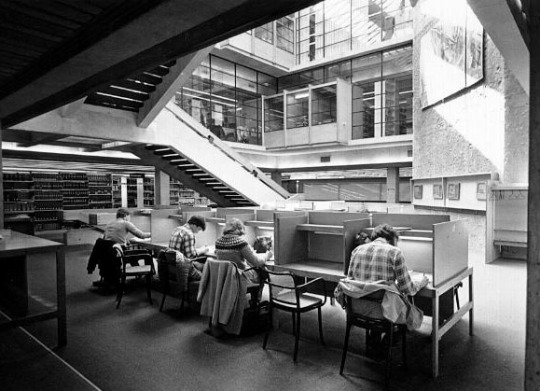
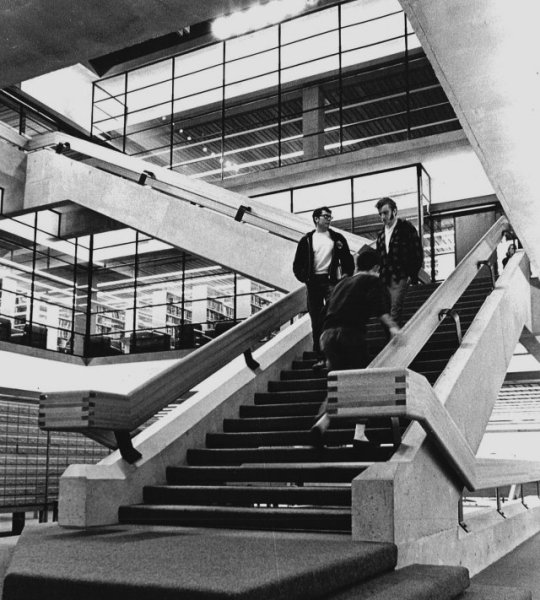
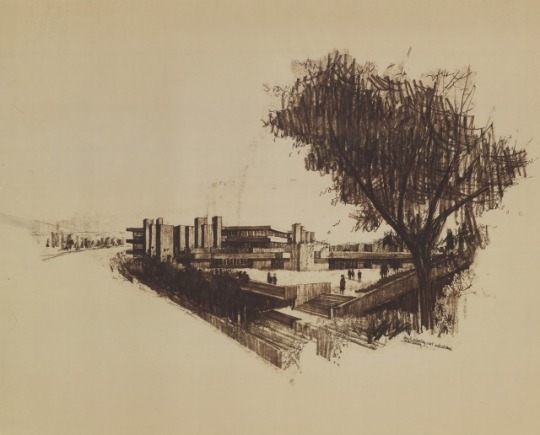
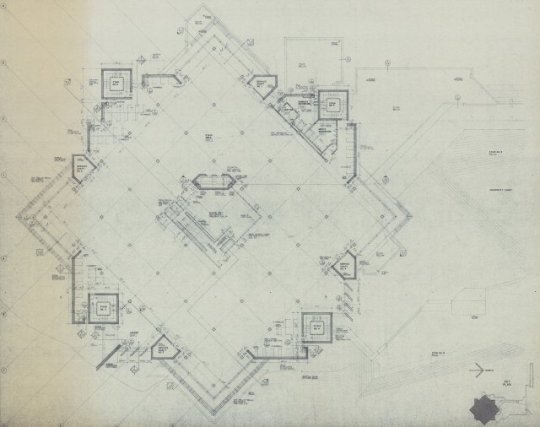
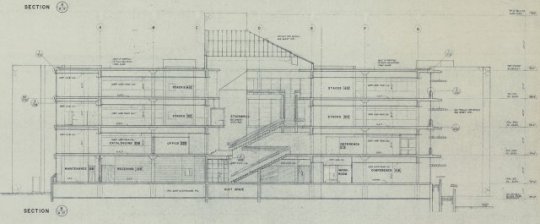
Bata Library, Trent University, Peterborough (1967-1969) by Ronald Thom. | Photo via FIG projects
Ronald Thom designed the masterplan of the Trent University campus in Peterborough and a series of buildings scattered on the premises. The Bata Library was located at the core of the campus, with the intention to become its focal point, dramatically overseeing the Otonabee river. The whole building is organized around a vast lobby that distributes natural light to the surrounding study areas. The walls of Bata are exposed-aggregate rubble and concrete, which Thom saw as matching closely the stone outcroppings of the area.

Scott Library, York University, North York (1968-1971) by John Parkin, John Bonnick, William Greer. | Photo via FIG projects
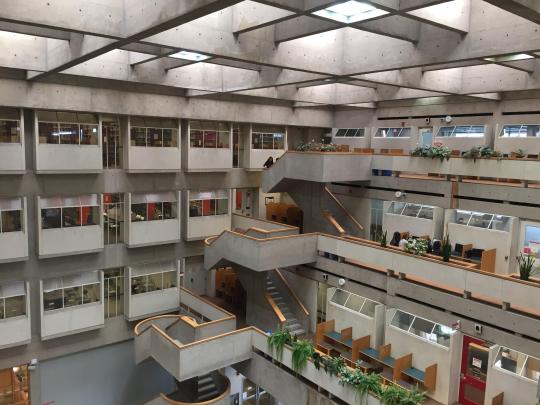
An austere inverted concrete ziqqurat to the outside, the indoors reveals a vast lobby towards which administrative and librarian offices are organized through a system of semi-public terraces with reading spaces. | Photo via FIG projects


Fisher Rare Books Library and Robarts Library, Toronto University (1968-1973) by Warner, Burns, Toan & Lunde. | Photo via FIG projects

Two adjacent buildings, holding the collections of Toronto University; the six floors volume of the Fisher Rare Books Library contains a breathtaking space dedicated to ancient and rare books. | Photo via FIG projects
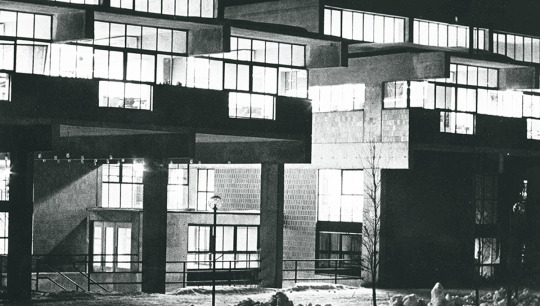
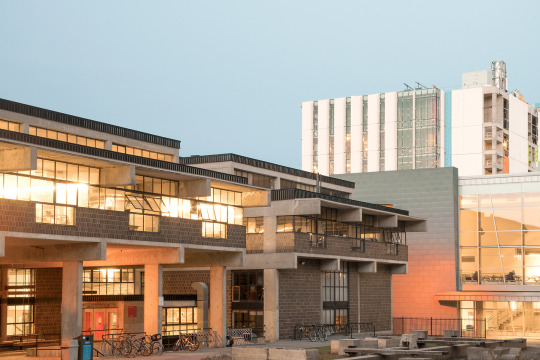
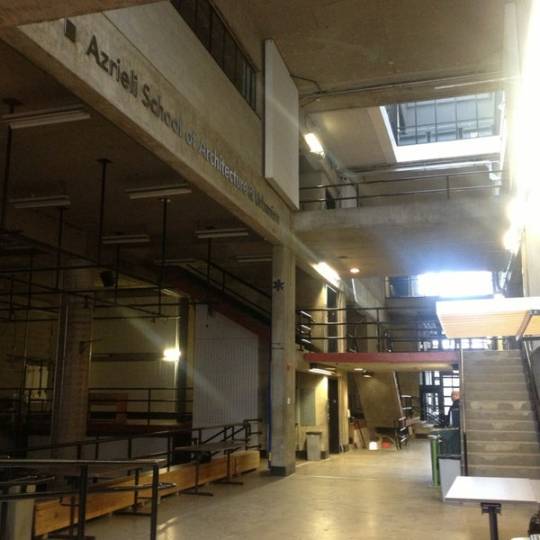
School of Architecture at Carleton University, Ottawa (1968) by Carmin and Eilin Corneil. | Photo via FIG projects
The stacked volumes of the studios and class-rooms are organized around the internal circulation, composed by a vast atrium that crosses the entire building, used as space for exhibition, lectures and students’ presentations. The whole language of the building is almost spartan with concrete and bricks left exposed as in an industrial building, hence underlying the productive nature of architectural studies.
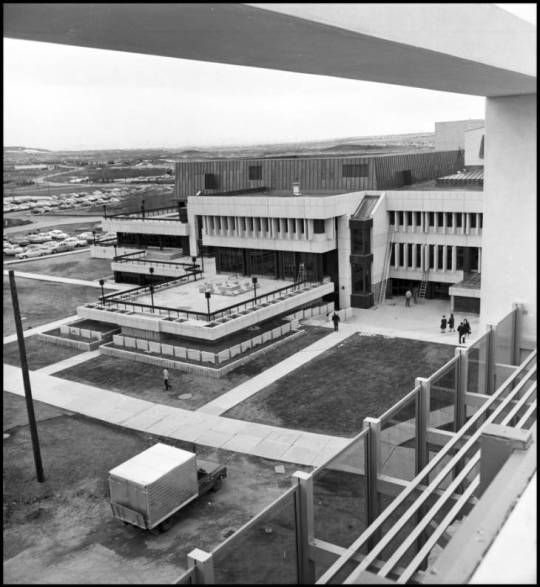
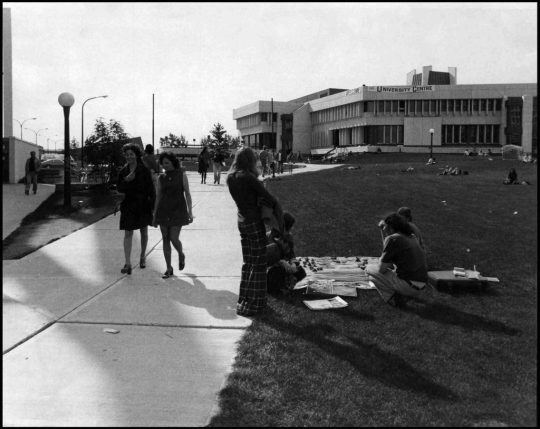
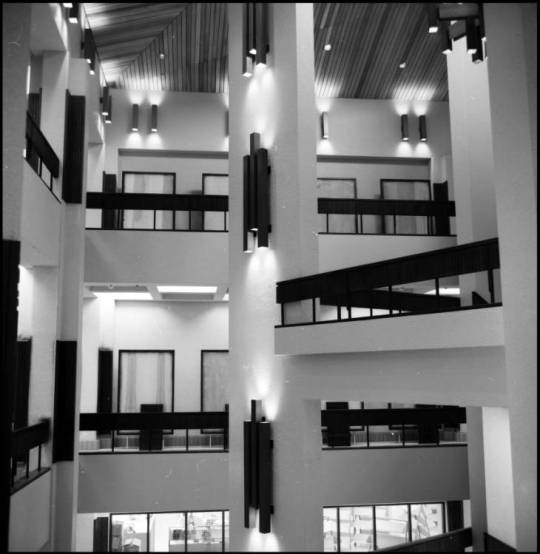

MacEwan Hall, University of Calgary (1967) by Stevenson Raines Barrett. | Photo via FIG projects
The seat of the students union of the new university, which in 1966 became autonomous from the University of Alberta. “In the early 1970s, MacEvan Hall included a food services area that seated 500, pool and ping-pong tables, a bowling alley, a 1,000 person dining room and ballroom, a fire pit lounge, a music lounge, a library, offices and meeting rooms, a bank, a barber, and a bookstore.”
“In the public domain the most important change distinguishing the new universities from the old is that the new universities are in the public domain in a manner, and to a degree, uncommon to the old. It is not simply that they are public institutions initiated and sustained by government grants. This was the case for many universities in the past. But most of the universities begun in the last decade … have stirred a wide interest and a sense of proprietorship in the communities in which they were established. The result is that these universities are in the public domain; not simply as public institutions, but as community projects.
Part of the mystique of the university has been torn away. The old university with its absent-minded professors and its ivy-covered walls is a romantic picture that stirs pleasant memories, but little enthusiasm as a model for today’s development. The new universities are “public property” in a sense that was not true of universities in the past. As a consequence, all aspects of the university’s life and work are being regarded afresh by many people unfamiliar with university traditions. And while these people are not unsympathetic with what they see, they do not hesitate to criticize sharply when they see fit. The university no longer enjoys an isolated and protected position in the community.”
– Murray G. Ross, president, York University, in University Affairs, April 1965.
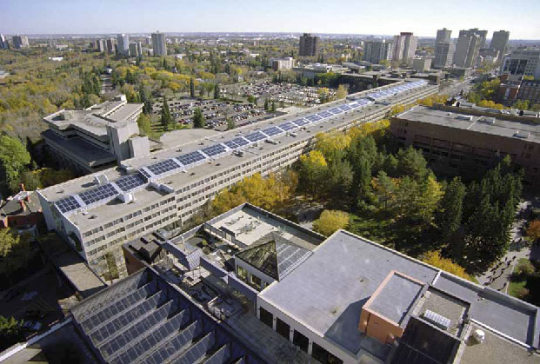


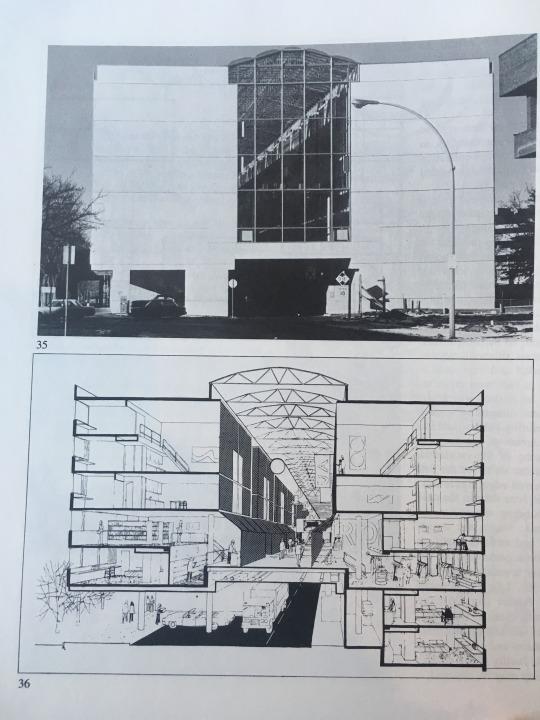
Housing Union Building (HUB), University of Alberta (1969-1971) by Diamond and Myers Architects with R.L. Wilkin. | Photo via Capital Modern
Designed by former Louis Kahn students, The Housing Union Building (HUB) was an innovative experiment in student housing, combining function and circulation in a new way. The elongated building was designed as a weather-enclosed concourse linking to other campus buildings, and as the acronym suggests, was intended to be a central focus on campus for students, staff and the general public.
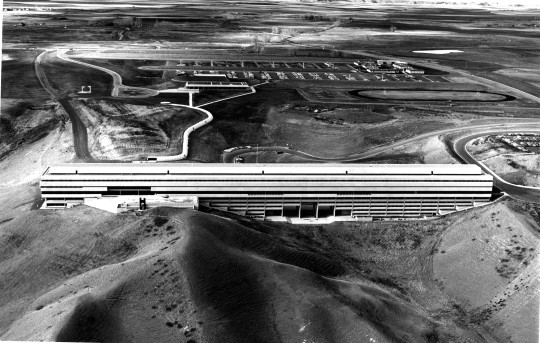


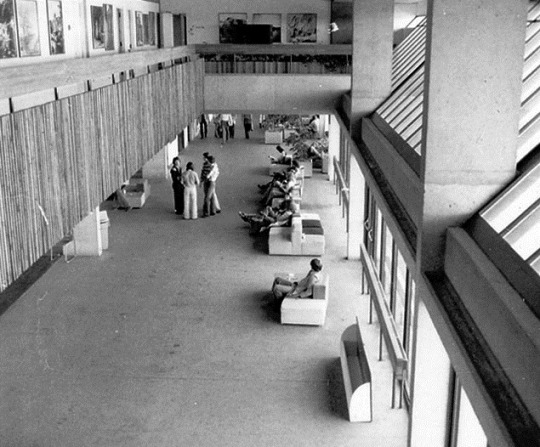

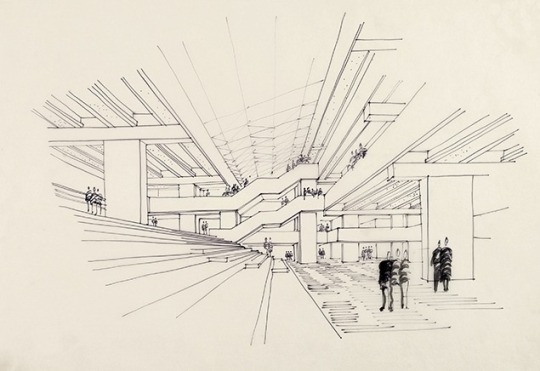
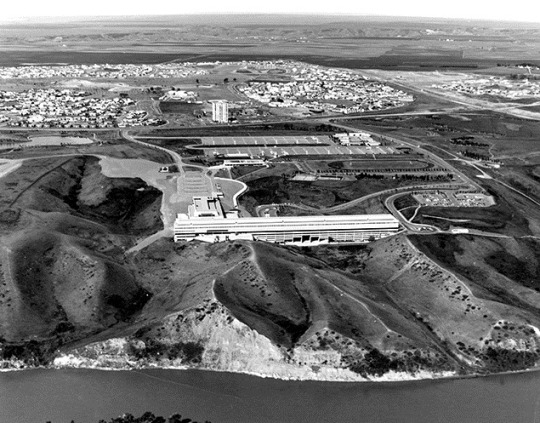
Lethbridge University Hall (1968-1969) by Arthur Erickson. | Photo via University of Lethbridge
Arthur Erickson, perhaps the early prototype of the starchitect, a globe-trotting cosmopolitan designer, created the main hall for the University of Lethbridge, founded in 1967. The elongated building, a land-art megastructure over a ravine, juxtaposed to the horizontal landscape of the prairies was organized along an extended walkway, a six storey concourse with a complex section, conceived as the central element of social gathering, especially during winter.



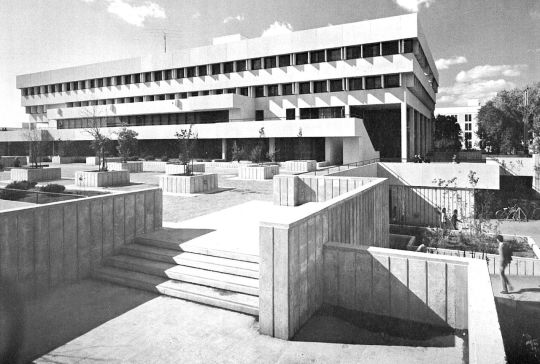

University Center, University of Manitoba, Winnipeg (1966-1969) by Number Ten Architectural Group. | Photo via Bohemian Blog
University Centre is a five-storey poured and pre-cast concrete structure constructed as part of a campus planning strategy that aimed to develop the campus as an urban centre. Overground facilities include dining space, offices and conference rooms, while the lounges, cafeteria, bookstore and open spaces for gathering were located below grade. University Centre serves as the central meeting point for all of the campus tunnels, culminating in a two-storey multifunctional space referred to as a “campo”.
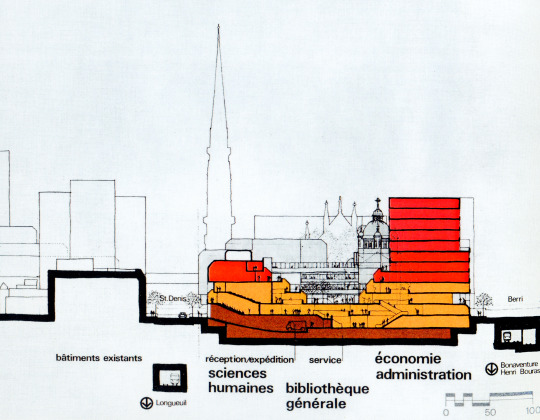
Located in a quite dense area of downtown Montréal, the two pavilions of the recently established Université du Quebéc à Montréal sit over metro lines, to which they are directly connected. A semi-underground concourse connects different educational facilities, such as cafeterias, auditoriums and class-rooms, creating dramatic spaces in correspondence of pre-existing heritage religious buildings, whose facades were incorporated in the general design.

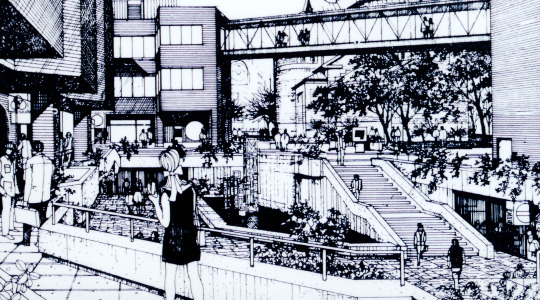
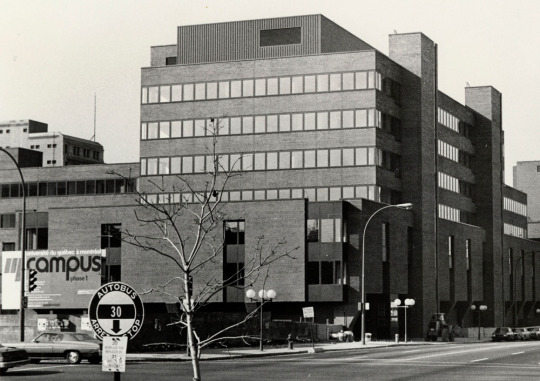



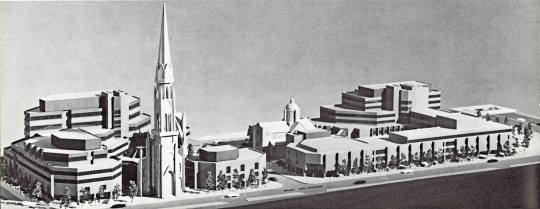
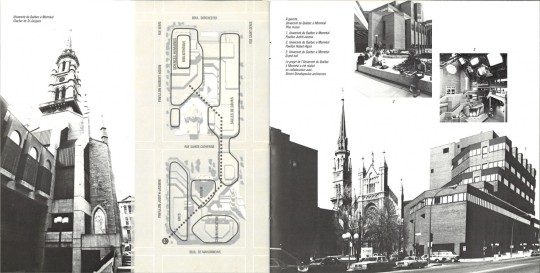
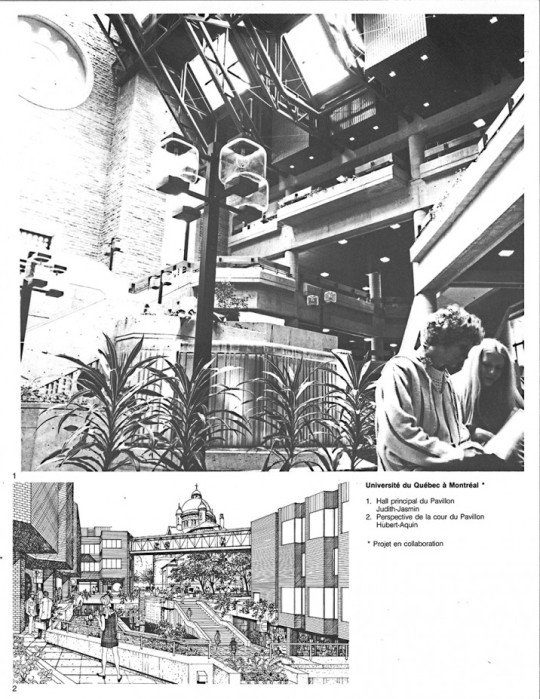
Pavillons Judith-Jasmin et Hubert-Aquin UQAM, Montréal (1974-1979) by Jodoin Pratte Lamarre and Dimitri Dimakopoulos. | Photo via © Jodoin Lamarre Pratte Architects
As a consequence of this ideological positioning, but also, of the peculiar climatic and geographical conditions of Canada, a few salient features can be read in the architecture and layout of many of the new facilities that sprouted in a very condensed period.
In particular, many projects shared the objective to interiorize within the envelope of the buildings, vast spaces for collective socialization, between students, faculty and staff. If the pastoral campus, inspired by Oxford or Cambridge was the model of the research university in the USA and of Canadian institutions between the XIX and XX centuries, one can identify in the new universities and in the additions and expansion of the existing ones of the ‘60s and ‘70s in Canada, the “galleria” as the dominant feature: a vast and climatically controlled environment for public life within an academic setting.
A very simplistic reading of such recurrent trope can just assume that as the majority of courses take place between September and May, when winter is the hardest, it is logical that indoor spaces are more important and more frequented than the lawns, courtyards, quadrants and gardens of universities in milder climates. Covered plazas, multi-storeys lobbies, expanded circulations, sky-lit concourses and indoor streets were part of an arsenal of architectural and typological tools mobilized by designers so as to accompany the surge of a new middle class of educated professionals, and to interiorize a strong idea of the “urban” inside the life of students. Such generosity was especially striking if compared to the tiny and cramped spaces of classrooms, laboratories, libraries and administrative offices of the university buildings from the first half of the XX century, often devoid of any places for informal exchange.
Still now, these vast indoor fragments of city life are extremely popular an used.
---
#FOMA 33: FIG Projects

FIG projects was founded by architects Fabrizio Gallanti and Francisca Insulza in 2003 in Santiago de Chile and is currently based in Montréal, Canada. FIG projects explores the boundaries between architecture, urban research and visual arts and promotes interdisciplinary initiatives. Wide ranging in nature, their practice extends from architectural explorations (new seat for the Literature School, Universidad Diego Portales, 2003-2005, Santiago, Chile; first prize Europan 8 competition, Kristiansand, Norway, 2006), urban studies (The Block, 2004; SARS Atlas 2006; Donde? 2006-2019), writing (Fan Club series for Interwoven magazine, 2016-2018) and curatorial projects (The World in Our Eyes, Lisbon Architecture Triennale, 2016). FIG projects work has been exhibited in different venues including Museo de Arte Contemporaneo, Santiago de Chile; exo.org, São Paulo; film + arch, Graz; Architecture and Urbanism Biennale, Shenzhen Hong Kong; Canadian Centre for Architecture, Montreal; Venice Architecture Biennale; Archivo Diseño y Arquitectura, México, Storefront Gallery for Art and Architecture, New York and Flint Free Festival, published in books such as “USE, Uncertain States of Europe” and international magazines as Domus, A+U or the Harvard Design Magazine.
484 notes
·
View notes
Text
100 reasons to vote for #JoeBiden that don't mention Trump. I didn’t compile the list, and I think there’s LOTS more on climate science, but anyway, what are your favorites? 13, 18, oh geez, all the 50s and 70s... not that he can DO all this....
1.) $15.00 federal minimum wage
2.) Reinstate DACA – allowing new applicants to apply
3.) 12 Weeks federal paid family leave
4.) Universal Pre-Kindergarten/Childcare for ages 3 and 4
5.) Tuition free college for those with household income less than $125,000.00
6.) Allow student loans to be relieved in bankruptcy
7.) LGBTQ+ Equality Act in the first 100 days in office
8.) Rejoin the Paris Climate Accords
9.) Decriminalize cannabis use and expunge convictions
10.) Eliminate cash bail system
11.) Eliminate mandatory inimum sentences
12.) Outlaw all online firearm and munition sales
13.) Restore the voting rights act
14.) Create a new $20 billion competitive grant program to spur states to shift from incarceration to prevention.
15.) He’ll triple funding for Title I Programs
16.) Appoint the first Black Woman to the Supreme Court of the United States
17.) Reauthorize the Violence Against Women Act (VAWA)
18.) Ensure the US achieves a 100% clean energy economy and net-zero emissions no later than 2050
19.) Protecting Biodiversity, slowing extinction rates and helping leverage natural climate solutions
20.) Develop a plan to ensure that America has the cleanest, safest and fastest rail system in the world, for both passengers and freight
21.) Expand the safety net for survivors
22.) Confront online harassment, abuse and stalking
23.) End the rape kit backlog
24.) Address the deadly combination of guns and domestic violence
25.) Change the culture that enables domestic violence
26.) Support the diverse needs of survivors of violence against women
27.) Protect and empower immigrant women
28.) Lead the global effort to end gender-based violence
29.) End capital punishment
30.) End federal private prisons
31.) End all incarceration for drug use alone and divert individuals to drug courts and treatment
32.) Invest in public defenders’ offices to ensure defendants’ access to quality counsel
33.) Expand and use the power of the US Justice Department to address systemic misconduct in police departments and prosecutors’ offices
34.) Reform qualified immunity for officers
35.) Ban choke-holds/neck restraints by police
36.) Launch a national police oversight commission
37.) Stop transferring weapons of war to police force
38.) Free access to testing for all with national testing board
39.) Double drive through testing sites
40.) 100,000 contact tracing workforce
41.) Guarantee first responders have priority access to PPE
42.) Emergency paid leave for anyone who gets COVID or needs to take care of a loved one
43.) Free housing for health care workers to quarantine
44.) Ramp up large scale manufacturing of as many vaccine candidates as necessary
45.) Nationwide vaccination campaign to guarantee fair distribution
46.) Ask every American to wear a mask
47.) End the mismanagement of the asylum system, which fuels violence and chaos at the border
48.) Surge humanitarian resources to the border and foster public-private initiatives
49.) End prolonged detention and reinvest in a case management program
50.) Rescind the un-American travel and refugee bans, also referred to as “Muslim bans.”
51.) Order an immediate review of Temporary Protected Status (TPS) for vulnerable populations who cannot find safety in their countries ripped apart by violence or disaster
52.) Ensure that Immigration and Customs Enforcement (ICE) and Customs and Border Protection (CBP) personnel abide by professional standards and are held accountable for inhumane treatment.
53.) Revitalize the Task Force on New Americans and boost our economy by prioritizing integration, promoting immigrant entrepreneurship, increasing access to language instruction, and promoting civil engagement.
54.) Convene a regional meeting of leaders, including from El Salvador, Guatemala, Honduras, Mexico, and Canada, to address the factors driving migration and to propose a regional resettlement solution
55.) Raising the corporate tax rate to 28 percent.
56.) Requiring a true minimum tax on ALL foreign earnings of United States companies located overseas so that we do our part to put an end to the global race to the bottom that rewards global tax havens. This will be 21% — TWICE the rate of the Trump offshoring tax rate and will apply to all income.
57.) Imposing a tax penalty on corporations that ship jobs overseas in order to sell products back to America.
58.) Imposing a 15% minimum tax on book income so that no corporation gets away with paying no taxes.
59.) Raising the top individual income rate back to 39.6 percent.
60.) Asking those making more than $1 million to pay the same rate on investment income that they do on their wages.
61.) Tackle the crisis of Missing and Murdered Indigenous Women
62.) Ensure tribal nations will have a strong voice and role in the federal government
63.) Restore Tribal lands and safeguard natural and cultural resources
64.) Joe will dramatically increase funding for both public schools and Bureau of Indian Education schools.
65.) Invest $70 billion in Tribal Colleges and Universities and Minority Serving Institutions.
66.) Ensure full inclusion of people with disabilities in policy development and aggressively enforce the civil rights of people with disabilities.
67.) Guarantee access to high-quality, affordable health care, including mental health care, and expand access to home and community-based services and long-term services and supports in the most integrated setting appropriate to each person’s needs and based on self-determination.
68.) Expand competitive, integrated employment opportunities for people with disabilities.
69.) Protect and strengthen economic security for people with disabilities.
70.) Ensure that students with disabilities have access to educational programs and support they need to succeed, from early interventions to post-secondary education.
71.) Expand access to accessible, integrated, and affordable housing, transportation, and assistive technologies and protect people with disabilities in emergencies.
72.) Advance global disability rights
73.) Double the number of psychologists, guidance counselors, nurses, social workers, and other health professionals in our schools so our kids get the mental health care they need
74.) Invest in our schools to eliminate the funding gap between white and non-white districts, and rich and poor districts
75.) Improve teacher diversity
76.) Support our educators by giving them the pay and dignity they deserve.
77.) Invest in resources for our schools so students grow into physically and emotionally healthy adults, and educators can focus on teaching.
78.) Ensure that no child’s future is determined by their zip code, parents’ income, race, or disability.
79.) Provide every middle and high school student a path to a successful career.
80.) Start investing in our children at birth.
81.) Double funding for the State Small Business Credit Initiative.
82.) Expand the New Markets Tax Credit, make the program permanent, and double Community Development Financial Institutions (CDFI) funding
83.) Improve and expand the Small Business Administration programs that most effectively support African American-owned businesses.
84.) Increase funding for the Minority Business Development Agency budget.
85.) Make sure economic relief because of COVID-19 reaches the African American businesses that need it most
86.) Reserve half of all the new PPP funds for small businesses with 50 employees or less
87.) Help families buy their first homes and build wealth by creating a new refundable, advanceable tax credit of up to $15,000
88.) Protect homeowners and renters from abusive lenders and landlords through a new Homeowner and Renter Bill of Rights.
89.) Establishing a $100 billion Affordable Housing Fund to construct and upgrade affordable housing
90.) Fully implement Congressman Clyburn’s 10-20-30 Plan to help all individuals living in persistently impoverished communities
91.) Expand access to $100 billion in low-interest business loans by funding state, local, tribal, and non-profit lending programs in Latino communities and other communities of color and strengthening Community Development Financial Institutions (CDFIs
92.) Expand broadband access to every American.
93.) Protect and build on the Affordable Care Act to improve access to quality health care in rural communities.
94.) Expand access to high-quality education in rural schools.
95.) Transform our crumbling transportation infrastructure – including roads and bridges, rail, aviation, ports, and inland waterways.
96.) Expand bio-based manufacturing to bring cutting-edge manufacturing jobs back to rural America.
97.) Strengthen antitrust enforcement
98.) Introduce a constitutional amendment to entirely eliminate private dollars from our federal elections
99.) End dark money groups
100.) Ban corporate PAC contributions to candidates, and prohibit lobbyist contributions to those who they lobby
Compiled by David Frree
***EDIT*** thisis all from his website. I, David, literally copy pasted the bullet points from his website. If you go on his website, click Joe’s Vision, he has different themes. “Criminal justice reform, helping America’s farmers, etc.” I clicked through a bunch of those, and tried to get the quickest bullet points from his website.
8 notes
·
View notes
Text
ART 311 - May 11, 2020 The Heroes’ Journey
The Heroes’ Journey is an extremely prolific narrative structure that we see everywhere around is entertainment media. In one of my previous posts, I listed some of my favourite authors and their works which are particularly important to me because of their effective world-building and foreshadowing. Many of these authors’ bodies of work feature stories which are solidly set within the Heroes’ Journey structure, but there’s one story not listed there that I would like to focus on specifically. That would be Contact by Carl Sagan, my single favourite stand-alone novel. As it was first published in 1985 and a movie adaptation starring Jodie Foster and Matthew McConaughey being released in 1997, I shouldn’t have to worry about spoilers, but here’s a spoiler warning: SPOILERS BELOW!

The premise of Contact is relatively simple. It’s a story about an astrophysicist performing SETI (Search for Extraterrestrial Intelligence) research at an radio-telescope array who receives what turns out to be a message from extraterrestrials, first contact, and the resultant reactions . As soon as most people hear that premise, they’ll assume that it’s either an apocalyptic armageddon style story, a science fiction horror story, or some sort of Star Trek First Contact style story where the aliens come to Earth and peacefully usher humanity into a new era. This story is none of the above. Instead, it’s a breathtakingly beautiful, moving, and awe-inspiring narrative supported by hard science fiction. Hard science fiction is science fiction which is soundly routed in factual science and mathematics. Anyone who comes to know me knows that I am hardly a religious or spiritual person, in fact I’m an outright atheist, however, this novel expresses in better form than I ever could in words the sense of the numinous which I feel when I see images like that of the Eagle Nebula’s Pillars of Creation (taken by the Hubble Telescope and released to the public in 2015), when I read papers on the research done at the LHC (CERN’s Large Hadron Collider in Europe), or when I read about advancements in technology and our understanding of the universe which can be used for the betterment of our species.

There are three acts to Contact much like any traditional Heroes’ Journey narrative: The Message, The Machine, and The Galaxy.
The Message:
Our protagonist, Eleanor “Ellie” Arroway, spends her early childhood being raised by supportive and loving parents, though her father Theodore “Ted” is the most influential on her life. He is her first mentor on her Heroes’ Journey, and helps to promote and develop her love of learning. From a young age Ellie is intensely inquisitive and devours new knowledge with a voracious appetite; she becomes particularly infatuated with the constant of π , known as “Pi”. This is of particular importance, so take note, and I would argue that this is Ellie’s call to adventure and is never refused or ignored. Unfortunately, while in sixth grade, her mentor and father Ted passes away to be replaced with her step-father John Staughton who is decidedly not supportive of Ellie’s non-feminine interests. Their acrimonious relationship is an important part to her characters development, though it was difficult for me to see it when I first read this novel as a teen.
The novel proceeds quickly through her middle and high school years, primarily using these years to highlight the sexism which was (and still is to a degree) wildly rampant in the STEM fields at the time. I viewed much of this to be further motivation for our hero to pursue her goals, though now with the added motivation of proving her step-father's opinion of her interests to be wrong. Her post-secondary education furthers her love and interest of science, gives her experiences in more social pursuits (*cough* sexual et cetera *cough*), and introduces her to ETI (just look at SETI and guess), and two mentors: two role models with one also being an antagonist of sorts. All of this concludes with her graduation and employment with SETI.
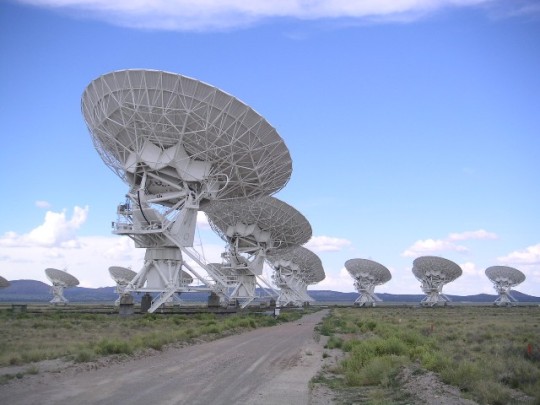
The first sign of extraterrestrial life is shown in the form Ellie discovering a repeating message of sequential prime numbers directed at Earth; this is not something that could randomly occur in nature. This is where the meat of the story begins; the crossing of the threshold. At first there’s skepticism among the scientific community, as there should be, but the message is received by unassociated and independent facilities. As the scientific community works through political channels to ensure redundant monitoring (this is set during the Cold War era) humanity is temporarily united in this realization that we’re not alone in the universe and a desire for further knowledge. This all culminates in the discovery of humanity’s first ever high-powered radio broadcast embedded in the message being returned to us, and industrial innovations and schematics needed to create a machine of unknown purpose embedded even deeper. Thus ends Act 1.
The Machine:
Tests, allies, and enemies are abundant in this part of the novel. Honestly, this is one of the most exciting parts of the entire story for me with all of the political machinations, discussions of about the new technology imparted to humanity by the extraterrestrials (nearly all of which are theoretically possible and grounded in real science), and discussions surrounding the philosophical implications and dilemmas of this new reality. I will glaze over most of it because otherwise this post would truly become a short novel in its own right.
The most important bits to take from this act (in my opinion) are the tests and enemies and approaching the inmost cave. The tests of Ellie’s dedication to following through with her life’s work in finding new funding and conquering adversity in the form of unnecessarily contrarian colleagues and critics, personal relationship, and physical and psychological recovery after a traumatic event. The enemies of this act are primarily the extremist religious and political groups which oppose the construction of The Machine and/or want to bring on the rapture, and . They ultimately destroy The Machine which is being built and funded by the government of the United States in a terrorist attack, and this appears to be the nail in the coffin of the project. The only way in which this is salvaged is through the efforts of an ally Ellie, who has a back-up machine in the works that was being used for “testing” components. The ordeal of this movie is undoubtedly the moment of activation of the machine, when the passengers and the world are witnessing the processes taking place from the opposing perspectives of the interior and exterior. The five passengers within the machine were confronting their fear of the absolute unknown considering this is a machine of foreign origin and technology never before used. Here ends Act 2.
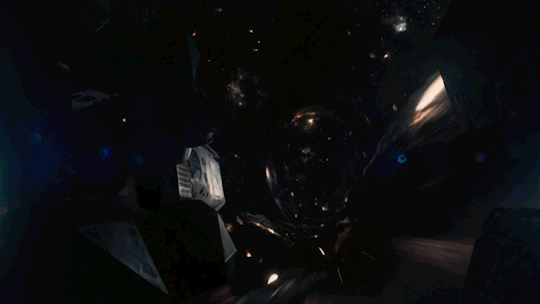
(I am aware that this is Interstellar, not Contact. I just couldn’t find a GIF from Contact)
The Galaxy:
Approaching the inmost cave is what the story transitions into after The Machine activates as the passengers pass into the wormhole network which transports them to The Station. This would also likely cover the Reward (Seizing the Sword) phase. Throughout this sequence in the novel Ellie and the rest of the passengers are getting their first real reward to years of work and dedication with The Message and The Machine, but it’s obvious to the characters and audience that they’re currently in transit somewhere which has further implications on the story/mission. The trip to the station is an endless montage of breathtaking and mind-blowing scenes showing the depth and breadth of the capabilities of the extraterrestrials. Upon arrival, the passengers experience isolation and we later learn that the extraterrestrials were inspecting their memories. They used this data to put each passenger through a highly emotional and cathartic experience which was used to teach each passenger something about themselves of value. It is also when the most beautiful and numinous piece of information is given to Ellie when she asks the alien, who has appeared before her as her dead father Ted, how they experience when they create the numinous (she learned from the alien that the aliens are currently building a freaking galaxy, Cygnus A, using Sagittarius A which is the supermassive black hole in the center of our Galaxy, and is a massively powerful source of radio signals. Already a freaking numinous feat). It answers with Pi. Imagine how this would impact Ellie. Her "discovery” of Pi was one of the most formative experiences of Ellie’s early life. Specifically, the alien states that buried in Pi’s decimals is an encoded message. Imagine. Pi is a universal constant. It is something determined by physical and mathematical relations that just exist; you can’t “build” or “encode” Pi. The alien goes on to describe how they found this message in vague detail and directs Ellie on where to look.This entire combination of phases only concludes once the passengers have returned to Earth.

Their return could likely be classified as combination of the Roadblock phase. Upon their return to Earth, rather than Ellie and the other passengers having a triumphant and joyous return no time appears to have passed on Earth, despite them having spent hours if not days on The Station. They are questioned. There are Inquiries. Politicians and the public are furious that billions of dollars were “wasted” on something that apparently just spun up to a specific speed in place, then stopped. None of the instruments of human origin attached to The Machine recorded anything; there was no sense of movement, no great amount of time had passed just mere moments, no radiation, nothing. Eventually, all of the inquiries “determine” that it was all a big hoax perpetrated by some evil capitalist (the ally that Ellie secured funding and the backup machine from) in order to amass wealth and develop a monopoly on many of the associated technologies and emerging industries. The detection of The Message was all done via the coordination of desperate SETI scientists with this man and his satellites up in space to defraud the world. Fortunately none of the passengers are punished in any way, despite many of them having been scientists deeply involved with the discovery, decoding, and understand of The Message and the construction of The Machine.
The Return of the Elixir phase in this novel is both a phase to be celebrated and mourned. Ellie discovers that her father Ted wasn’t her biological father and that instead the man she thought was her step-father was her biological father. This is a loss of identity that she mourns deeply, but with the experience, perspective, and humility she has gained through this whole journey she is able to forgive her mother’s infidelity and come to terms with this bit of knowledge. She is also able to conduct research regarding Pi to help confirm her story regarding their journey in The Machine and discovers the message hidden in Pi’s decimals. A perfect circle. Ironic as hell and yet an absolutely beautiful impossibility thrown in by Carl Sagan that elicits a sense of the numinous in anyone I know who has read the novel. In closing, not only has Ellie’s Heroes’ Journey given her more wisdom and grace as a human, but also a powerful piece of knowledge that validates her entire experience and does the very thing scientists hunger for the most: she expanded humanity’s understand of the universe and of how much there is more to discover.
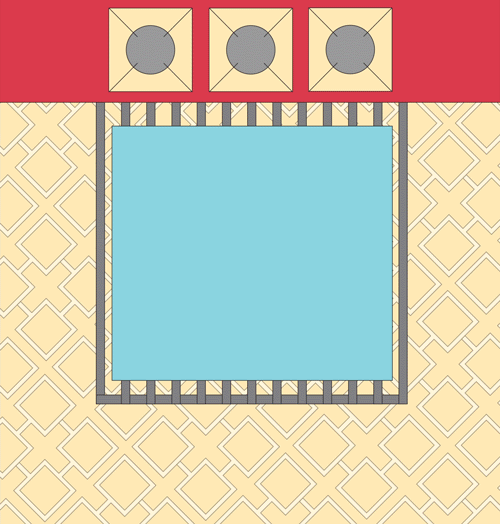
I know that that was one hell of a lot of word vomit on the blog, so if you read it all the way then thank you.
26 notes
·
View notes